
About UsThe Numismatic Bibliomania Society is a non-profit organization devoted to the study and enjoyment of numismatic literature. For more information please see our web site at coinbooks.org SubscriptionsThose wishing to become new E-Sylum subscribers (or wishing to Unsubscribe) can go to the following web page link MembershipThere is a membership application available on the web site Membership Application To join, print the application and return it with your check to the address printed on the application. Membership is only $20 to addresses in the U.S., $25 for First Class mail, and $30 elsewhere. For those without web access, write to: David M. Sundman, Treasurer AsylumFor Asylum mailing address changes and other membership questions, contact David at this email address: dsundman@LittletonCoin.com SubmissionsTo submit items for publication in The E-Sylum, just Reply to this message, or write to the Editor at this address: whomren@gmail.com BUY THE BOOK BEFORE THE COIN |
- WAYNE'S WORDS: THE E-SYLUM MARCH 1, 2015
- KOLBE & FANNING ONLINE SALE RESULTS
- NEW BOOK: 2016 DELUXE EDITION RED BOOK
- BOOK REVIEW: COINS AND COLLECTORS, GOLDEN ANNIVERSARY EDITION
- BOOK REVIEW: ARTUR IMMANUEL LOEWENTAL
- LARGE NUMISMATIC BOOKS: MARIS' NEW JERSEY
- 1755 CATALOGUE OF RICHARD MEAD'S COLLECTION
- ANS PARTNERS WITH HATHITRUST
- LATIN AMERICAN BANKNOTES RECORDS NOW ONLINE
- HARRINGTON MANVILLE, 1929-2015
- RICHARD B. WITSCHONKE, 1945-2015
- NOTES FROM E-SYLUM READERS: MARCH 1, 2015
- KUZNETS 1971 NOBEL MEDAL SELLS FOR $390,848
- ARTICLE HIGHLIGHTS NATIONAL BANK NOTE HISTORY
- KNIGHTS OF PYTHIAS ORPHANAGE MEDAL
- WWI LALIQUE ORPHANAGE PIN BADGE
- SHORT SNORTERS TO PROMOTE PORTLAND ANA SHOW
- COSTA RICA NOTES AT LYN KNIGHT 2015 CPMX SALE
- ROYAL MINT UNVEILS NEW LIKENESS OF BRITANNIA
- ROYAL MINT: COINS THAT NEVER WERE
- ROMAN PROVINCIAL COIN ATTRIBUTIONS SUGGESTED
- MINT OF POLAND STRIKES SPHERICAL COIN
- FOUNTAINS ABBEY SETTLERS LABOR EXCHANGE TOKEN
- 1964 COMIC ABOUT COINS AND COLLECTORS
- VINT CERF PROPOSES 'DIGITAL VELLUM' TO PRESERVE ELECTRONIC WORKS
- ISIS DESTROYS MOSUL PUBLIC LIBRARY
- ARGENTINA'S NEW BANKNOTE RILES FALKLAND ISLANDERS
- NEW €20 BANKNOTE UNVEILED
- THAILAND ISSUES NEW 100-BAHT BANKNOTE
- CANADIANS HONOR LEONARD NIMOY WITH "SPOCK" NOTES
- SOME RECENT COIN DESIGNS: MARCH 1, 2015
- THE AGNUS DEI PENNY
- COINS OF THE ANGLO-SAXONS
- ISRAEL STRUGGLES TO STOP ARCHAEOLOGICAL SITE RAIDS
- TREASURE HUNTERS SEEK CONFEDERATE GOLD IN LAKE MICHIGAN
- EXHIBIT HIGHLIGHTS COUNTERFEIT CHINESE NOTES MADE BY JAPAN
- COUNTERFEITING $100 BILLS WITH NAPKINS
- COUNTERFEITING - IN REVERSE
- FEATURED WEB SITE: THE SHORT SNORTER PROJECT
Click here to access the complete archive
To comment or submit articles, reply to whomren@gmail.com
WAYNE'S WORDS: THE E-SYLUM MARCH 1, 2015

New subscribers this week include: John and Margaret Humphris, courtesy of Jeff Starck, Suzy Carthel, Enrico Introini, and Errol Rojas. Welcome aboard! We now have 1,826 subscribers.
This week we open with results of the first Kolbe & Fanning online-only auction, a new book, and two reviews. Other topics include Maris' Coins of New Jersey, Harry Manville, Rick Witschonke, short snorters, Britannia, a Labor Exchange token, and Confederate gold in Lake Michigan.
To learn more about Alfred S. Robinson, the 1955 ANA Convention, porcupine coins, thrymsas and scillingas, Richard Mead's collection, Ronald Reagan and the Higgins Museum, the spherical coin, and the Welsh dragon "ha'penny", read on. Have a great week, everyone!
Wayne Homren
Editor, The E-Sylum
KOLBE & FANNING ONLINE SALE RESULTS
Kolbe & Fanning Numismatic Booksellers held their first purely online auction of numismatic books on Saturday, February 28, through the firm’s internet bidding portal at auction.numislit.com. The sale offered 380 lots of North American numismatic literature and was a fine success.
This is the first in what is expected to be a series of smaller online numismatic book auctions held by Kolbe & Fanning in addition to their traditional printed and public auctions. The lots were all illustrated and fully described, and bidders were able to browse through the lots and leave absentee bids in the days leading up to sale. Many bidders participated in this manner, so that nearly 60% of the lots had bids on them before the live auction began at noon on Saturday.
Real-time bidding was also quite spirited and those participating in the live sale saw strong action on a variety of lots, with some highlights as follows:
Thirty-one lots of pre-WWII volumes of The Numismatist (lots 3 through 33), did very well, nearly all bringing over estimate. The 1896 and 1897 volumes brought $425 each (all prices quoted here are hammer prices and do not include the buyer’s premium).
S.H. & H. Chapman’s 1895 sale of the E.J.M. Chaloner collection, with plates (lot 96), brought a strong $550 hammer.
Nice copies of the Bushnell and H.P. Smith collections, with reprint plates (lots 93 and 97), also brought strong prices of $375 and $425, respectively.
Lot 228, a copy of the Lyman Low sale of the Benjamin Betts collection, brought $650 on a $350 estimate.
 Perhaps the greatest action of the sale came with lot 276, a rare 1861 catalogue of coins and medals for sale by Alfred S. Robinson. This copy had
last been sold in 2010, when it brought $220 in the firm’s 119th sale. Several bidders pursued this lot, with two of them going head to head and
pushing the sale price to $1700 hammer.
Perhaps the greatest action of the sale came with lot 276, a rare 1861 catalogue of coins and medals for sale by Alfred S. Robinson. This copy had
last been sold in 2010, when it brought $220 in the firm’s 119th sale. Several bidders pursued this lot, with two of them going head to head and
pushing the sale price to $1700 hammer.
Another fiercely contested item was lot 359, an offprint of a 1949 Saturday Evening Post promotional piece on B. Max Mehl, which ended up bringing $350 hammer.
Sale catalogues of W. Elliot Woodward continued to see strong demand, with plated copies of his 1885 J. Colvin Randall sale (lot 374) bringing $800 and his masterly All the Kingdoms of the World sale of 1884 (lot 372) bringing $650. Several unplated Woodward sales also brought very strong prices.
Kolbe & Fanning plan to hold a second online sale in several weeks, focusing on works on ancient and world coins. Details will, of course, be provided here in the near future. Thanks to everyone who participated and helped make this such a fun and successful sale.
NEW BOOK: 2016 DELUXE EDITION RED BOOK
 Whitman Publishing announces the release of a new reference, the Guide Book of United States Coins, Deluxe Edition, at the Whitman Baltimore
Coin and Collectibles Expo on March 26, 2015. Larger than the regular-edition Red Book, and with more pages, the Deluxe Edition retails for $49.95.
It can be pre-ordered online (including at Whitman.com) and after the Baltimore Expo will be available from booksellers and hobby shops nationwide.
It will be an annually updated and revised reference.
Whitman Publishing announces the release of a new reference, the Guide Book of United States Coins, Deluxe Edition, at the Whitman Baltimore
Coin and Collectibles Expo on March 26, 2015. Larger than the regular-edition Red Book, and with more pages, the Deluxe Edition retails for $49.95.
It can be pre-ordered online (including at Whitman.com) and after the Baltimore Expo will be available from booksellers and hobby shops nationwide.
It will be an annually updated and revised reference.
Billed as the “biggest, most useful Red Book ever,” the Deluxe Edition measures 7 x 10 inches and has 1,504 pages. The larger size and increased page count combined make the Deluxe Edition five times bigger than the regular-edition Red Book. It prices 8,018 items in up to 12 grades each, with 50,205 individual values and 16,667 auction records covering circulated, Mint State, and Proof coinage. The book is illustrated with 5,753 images.
The Deluxe Edition covers American coinage from New England colonial times to the modern day—half cents through $20 gold double eagles, plus bullion, commemoratives, Proof and Mint sets, significant tokens and medals, error coins, and other numismatic collectibles. It follows the basic structure of the regular-edition Red Book, but each chapter is dramatically expanded with more historical information, more die varieties, detailed grading instructions with enlarged full-color illustrations, specialized advice on strike characteristics and other technical details, market analysis, and valuable guidance on collecting and investing in rare coins.
The book’s Senior Editor is Kenneth Bressett, Valuations Editor is Jeff Garrett, and Research Editor is Q. David Bowers. A 57-page introduction, “The Story of American Money,” is based on the work of the late Dr. Richard Doty, senior curator of the National Numismatic Collection at the Smithsonian.
Each year, the new Deluxe Edition will feature an in-depth focus on one or more coin series. The first edition includes a special 364-page section on copper half cents and large cents written by Q. David Bowers, with images, history, diagnostics, and pricing for 832 die varieties, 1793–1857.
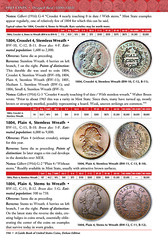
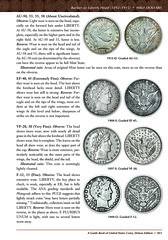
For federal coins, detailed charts show each mintage; a summary of certified population data; average national retail prices in grades ranging from About Good to high Mint State and Proof; and three or more recent auction records for most coins. Enlarged close-ups of die varieties provide visual guidance. Extensive chart notes give the back stories and additional details on significant coins.
“This is the biggest numismatic reference Whitman has ever created,” said publisher Dennis Tucker. “Many of the Deluxe Edition’s chapters could be standalone books themselves. The section on commemorative coins is 146 pages long. Pre-federal coins and tokens from the 1600s to the 1790s span 56 pages. U.S./Philippine coins of World War II and earlier are given a detailed 30-page treatment. And 364 pages of half cents and large cents are enough to make every reader a smarter buyer and collector.”
Special appendices include illustrated essays on misstrikes and error coins; rare and collectible numismatic books; bullion values of common-date silver and gold coins; the top 250 coin prices realized at auction; grading standards for U.S. coins; coin cleaning, preservation, and conservation; counterfeit coins in today’s marketplace; the dynamics of the rare-coin market; predicting the rare-coin market; and techniques of smart bidding at auction.
BOOK REVIEW: COINS AND COLLECTORS, GOLDEN ANNIVERSARY EDITION
by Q. David Bowers
a review by John W. Adams
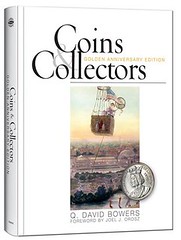 Numismatics is thriving. Many comparable hobbies are not. There are, no doubt, many reasons
for our good fortune. Chief among these, in our opinion, is one individual – Q David Bowers. If you want to debate with Ye Editor on this point, you
must either concede it or you will have to buy Dave’s latest (and perhaps his greatest) book, Coins & Collectors, Golden Anniversary
Edition.
Numismatics is thriving. Many comparable hobbies are not. There are, no doubt, many reasons
for our good fortune. Chief among these, in our opinion, is one individual – Q David Bowers. If you want to debate with Ye Editor on this point, you
must either concede it or you will have to buy Dave’s latest (and perhaps his greatest) book, Coins & Collectors, Golden Anniversary
Edition.
This book, an anthology of 51 stories about coins and associated personalities, can be read for simple pleasure. When titillated with titles like “Wyman the Wizard” and “A Hidden Treasure in the Woods”, who amongst us does not want to dive in?
Those with an economic bent will jump to the chapter on the rise and fall of the 1950-D nickel, whereas we medal mavens will seek out the stories of the Erie Canal medal and the 1838 New Haven medal. There is, quite literally, abundant reading for everyone.
In an eloquent Foreword to the book, Joel Orosz sets the table. He points out that the original Coins and Collectors arrived on the scene just as events were conspiring to doom the time-tested challenge of filling Whitman folders. The emission of hundreds of millions of Lincoln cents in the 1950’s and the 1960’s diluted materially the population of early date cents, at the same time that the astronomic rise in the price of silver led to the wholesale melting of collectible dimes, quarters and halves. Two generations of roll scavengers would have been removed from the hobby except for the timely arrival of Coins & Collectors, along with the many new vistas which it opened. The original edition of 10,000 was followed by a re-print of 100,000, staggering numbers for any book on coins except, of course, the universal Red Book. These book buyers were either introduced to the hobby or saved for the hobby by Bowers’ ability to convey the breadth and color, the history and personalities that comprise numismatics.
The Golden Anniversary Edition, although it is not on an obvious rescue mission, will serve as its predecessors did to recruit numismatists. It contains a cornucopia of topics, most of them educational and all of them entertaining. My personal favorites are the chapters on the 1933 Double Eagle and the one on the Norweb family. Both of these have a strong autobiographical dimension. Dave Bowers is known to all as a kindly soul, but the story of the 1933 Double eagle reveals his utter contempt for Mint officials who flog petty regulations that conscript the freedom of the hobby.
The chapter on the 1955 ANA Convention, the first attended by Bowers, reminds the reader just how long the man has been on the scene. Here a teenager, who must operate under his father’s guarantee, begins to build a reputation that, over the years, will grow to heroic proportions. In the new Coins & Collectors, whether in the narrative or between the lines, one comes to face with a multi-faceted giant of a man. So, yes, enjoy his story telling, but buy the book to make closer acquaintance. Those who know Q. David Bowers only casually or not at all will come away from the book feeling that he is an intimate friend. Those who know him well already come away inspired by glimpses of a man who, it now becomes clear, has made vast contributions to a hobby that thrives due, in no small part, to him.
For more information on the Medal Collectors of America (MCA) , see:
www.medalcollectors.org
To read the earlier E-Sylum article, see:
NEW BOOK: COINS AND COLLECTORS: GOLDEN ANNIVERSARY EDITION
(www.coinbooks.org/esylum_v17n09a03.html)
BOOK REVIEW: ARTUR IMMANUEL LOEWENTAL
A biography and catalog of the works of this sculptor has just been published in England and it is a great addition to the literature of the medal. Loewental's career was quite enigmatic. During WWI he worked in Berlin doing a series of medals for the German Government. He moved to England in 1934 to escape the rise of the Third Reich in Germany, became naturalized and in a quirk of fate worked for a UK Company active in producing war material for the allies in WWII.
This catalog mostly records the life and works of Loewental after his arrival in England. His work was usually singular in nature and he produced very few medals that were cast or struck in editions that reached two figures, One major exception was his Churchill Victory medal. The medal was first issued in 1945 in an edition of 1,000 2½-inch bronze examples and again in 1965 as a memorial to Churchill on his death. That issue was 2-inches in diameter with two gold, and single silver and bronze iterations. Total of 2,857 examples. It was this medal that made this reviewer aware of Loewental and introduced him to this consummate medallic sculptor. Here is the obverse and reverse of the 2-inch bronze from 1965

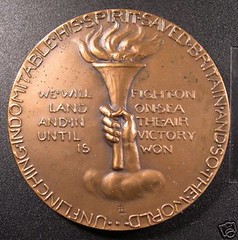
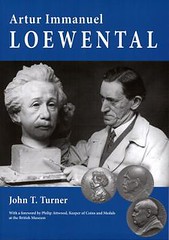 John
T Turner
John
T Turner
SLHA 2014
119pp Black & White
ISBN 978 0 903582 50 6
Paperback A4
£15.95 (£18.80 by post UK; £26.60 by post overseas)
Artur Immanuel Loewental (1879-1964) was a sculptor of rare talent who created medals of eminent people in Austria, Germany and Britain. Well known for his series of World War I German commemorative medals, his other subjects included Beethoven, Einstein and Kreisler.
Moving to Britain in 1934 – he was an Austrian Jew – his modeling skills with various materials continued to be in demand. The medals he sculpted of Kipling and Churchill achieved great acclaim.
For the last twenty years of his life he lived in or near Lincoln and large collections of his work are in either public or private hands in Lincolnshire today.
This study tells the story of a remarkable man and, for the first time, provides a detailed illustrated catalogue of the medals he sculpted.
For more information, or to order, see:
www.slha.org.uk/publications/slha_books/#
THE BOOK BAZARRE
LARGE NUMISMATIC BOOKS: MARIS' NEW JERSEY
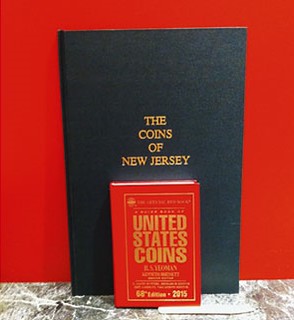 A couple of
“Numismatic Bookie” columns from 2013 to 2014 discussed the smallest numismatic literature: miniature books measuring as little as 2.375 inches
tall.
A couple of
“Numismatic Bookie” columns from 2013 to 2014 discussed the smallest numismatic literature: miniature books measuring as little as 2.375 inches
tall.
This month, we focus on the tallest American numismatic book, A Historic Sketch of the Coins of New Jersey, With a Plate. Its author, Edward Maris, was a physician by trade and a Quaker by faith, and judging by this book, he may have coined the contemporary admonition to “go big or go home.”
How big is The Coins of New Jersey? It towers over a copy of the “Red Book.” Standing a whopping 18.875 inches in height, it became the tallest numismatic book in America upon its publication in 1881, and has never relinquished that title. Most books are classified as octavo (the “Red Book”), or quarto (a major auction catalog).
The tallest volumes are classified as folio, but the Maris book is an “elephant folio,” which can measure up to 23 inches tall.
What was behind producing such an ostentatious skyscraper of a book? For Maris, it was all about the “Plate” in the subtitle. He identified varieties (82 obverse and 57 reverse) of New Jersey coppers, and sought to place, on a single photographic plate, an example of each, with drawn lines connecting die pairs.
It required 140 coin images to depict each obverse, reverse, and die marriage. Placing all on one page would allow comprehensive “at a glance” variety identification, but presenting 140 photographs big enough to show detail necessitated huge pages: hence the “elephant folio.”
Even in that jumbo format, the maximum was 70 individual images per page, so the plate is bound into the book folded in half.
Even 134 years after publication, these photos allow attribution of the coppers “at a glance,” just as Maris intended.
In an 1881 letter published in dealer Ed Frossard’s magazine Numisma, Maris projected publication of 115 books, but only 50 copies seem to have been printed. This combination of rarity and quality make The Coins of New Jersey one of the priciest books in American numismatics.
To read the complete article, see:
Large numismatic books worth a look like Maris' book
on the coins of New Jersey (www.coinworld.com/insights/Go-big-or-go-home-large-books-worth-a-look.html)
1755 CATALOGUE OF RICHARD MEAD'S COLLECTION
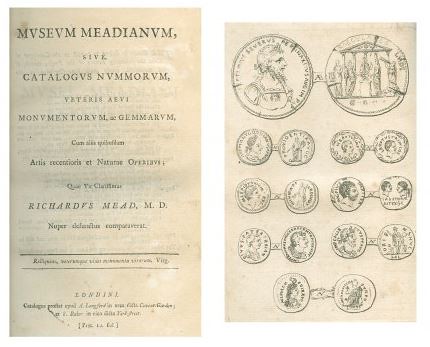
THE RARE AND IMPORTANT 1755 CATALOGUE OF RICHARD MEAD’S COLLECTION [Abraham Langford] Museum Meadianum sive Catalogus Nummorum, Veteris Aevi Monumentorum, ac Gemmarum, Cum aliis quibusdam Artis recentioris et Naturae Operibus; Quae Vir Clariffimus Richardus Mead, M. D. Nuper defenctus comparavet. London, 17th – 19th February, 1755. Printed for A. Langford in Covent Garden. Quarto, pp. engraved plate as frontispiece, title page, errata on verso, 262 pages, lots 1-141, 1-80, 1-80, 1-81, 1-76, 1-74, 1-61. Ruled throughout and hand annotated with prices realised and many buyers’ names. With; Musei Meadiani Pars Altera: Quae Veteris aevi Monumenta ac Gemmas, Cum aliis quibusdam Artis recentioris et Naturae Operibus, Complectitur. London, March 11th 1755. Continuously paginated, pp. (211)-262, lots curiously unnumbered but ruled throughout with prices realised, small errata list at end. Tastefully bound in three quarter black morocco, five raised bands, lettered and ruled in gilt, top edge gilt. Marbled endpapers with manuscript note written by Leopold George P. Messenger taped onto first pastedown. Contents remarkably clean with some insignificant browning. A remarkably fresh copy of this fascinating catalogue containing many major rarities.
Early catalogues such as this are rarely seen, especially when hand annotated and in such a good state of preservation, as here. Exceptionally rare thus. Richard Mead (1673-1754) was an eminent Royal Physician who in his lifetime attended to Sir Isaac Newton as well as both Queen Anne and George II. Author of a number of renowned medical texts he is most remembered for the ground breaking work, ‘A Short Discourse concerning Pestilential Contagion, and the Method to be used to prevent it’ (1720) - revolutionary at the time for its understanding of contagious diseases.
His decision to collect coins came rather late in life and upon the prompting of his second wife whom he married in 1724. During this relatively short time he managed to build a vast collection consisting of Ancient Greek coins (this series was sold to Angel Carney and Patrick Kennedy prior to the auction), Roman coins, British coins and Commemorative Medals. The present volume also details his impressive collection of Gems and Antiquities.
“Mead’s sale offered the most extensive collection of coins available in London to that date and the purchasers included many well-known eighteenth century English Collectors”.
Notable highlights of his collection include, on the first day two exceptionally rare Aurei, lot 17, of Pompeius (£25.0.0) and lot 19, of Brutus (£22.10.0), on the second day, lot 110, an Aureus of Allectus (£21.5.0). On the sixth day of the sale, lot 26, an Elizabeth I Portcullis Crown (£4.4.0), lot 38, a Charles II Petition Crown, “highly preserved” (£12.0.0), and lot 76, an “exquisite fine” Fifty Shilling piece of Oliver Cromwell (£9.0.0), on the seventh day, lot 21, a Twenty Pound Scottish piece of James VI described as being “A large beautiful piece” (£4.10.0), and on the eighth day, lot 48 (p.197), “An exquisite fine oval Gold Medal upon Admiral Blake’s Victory at Sea by Thomas Simon” (£21.0.0). As Manville states, ‘Many lots contained 20-40 Roman Coins, each described with full legends, which helps to explain the catalogues length of more than 200 pages for fewer than 600 lots.’ The total value of the sale realised an incredible £1,997.17.0, unheard of at this time.
For more information, or to order, see:
Catalogue of Richard Mead's Collection 1755
(www.baldwin.co.uk/catalogue-of-richard-mead-s-collection-1755.html)
For all of the Baldwin's stock of books, see:
www.baldwin.co.uk/catalog/category/view/id/321
ANS PARTNERS WITH HATHITRUST
In a sweeping effort to make its older and out-of-print publications available to the public as Open Access, the ANS has partnered with HathiTrust As a result of this partnership, scans of nearly 550 ANS titles – including the American Journal of Numismatics, Numismatic Literature, Numismatic Notes and Monographs, and stand-alone monographs, have become fully readable and downloadable to anyone who wants them under a Creative Commons, non-commercial, attribution, share-alike license. This means that these ANS publications can be used for personal reading, research, and academic publication just so long as the ANS is cited as the source. Titles currently in the public domain already have a home on HathiTrust. . These volumes were OCR-scanned as part of the Google Books project.
HathiTrust, founded in 2008 by 13 universities of the Committee on Institutional Cooperation and the University of California, is a large, collaborative repository of digital content from research libraries and publishers that includes content digitized by Google Books and Internet Archive and Microsoft. Millions of volumes are available via HathiTrust’s website (http://www.hathitrust.org). The entire repository can be full-text searched.
For more information contact Andrew Reinhard, Director of Publications, at areinhard@numismatics.org.
To read the complete press release, see:
ANS Partners with HathiTrust for Open Access Publications
(http://numismatics.org/NewsEvents/PR20150220hathitrust)
For more information on HaithiTrust, see:
Welcome to the Shared Digital Future (www.hathitrust.org/about)
LATIN AMERICAN BANKNOTES RECORDS NOW ONLINE
Author Ricardo Magan writes:
Dear friends, I would like to inform you that you can now see and download my book, Latin American Banknotes Records online at archive.org
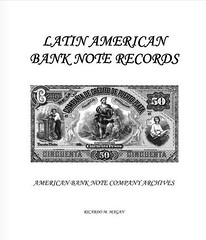 The book is a catalogue of Latin American banknotes produced by the American Bank Note Company for the
following countries: Argentina, Bolivia, Brazil, Chile, Colombia, Costa Rica, Cuba, Dominican Republic, Ecuador, El Salvador, Guatemala, Haiti,
Honduras, Mexico, Nicaragua, Paraguay, Peru, Puerto Rico, Uruguay and Venezuela.
The book is a catalogue of Latin American banknotes produced by the American Bank Note Company for the
following countries: Argentina, Bolivia, Brazil, Chile, Colombia, Costa Rica, Cuba, Dominican Republic, Ecuador, El Salvador, Guatemala, Haiti,
Honduras, Mexico, Nicaragua, Paraguay, Peru, Puerto Rico, Uruguay and Venezuela.
Over two thousand banknotes are listed from two hundred and seventy two banks and government issuing authorities throughout Latin America.
To read the complete book, see:
Latin American Banknote Records (2005)
(https://archive.org/details/LatinAmericanBanknotesRecords)
To read the earlier E-Sylum article, see:
NEW BOOK ON LATIN AMERICAN BANK NOTES (www.coinbooks.org/esylum_v08n32a15.html)
THE BOOK BAZARRE
HARRINGTON MANVILLE, 1929-2015
Douglas Saville writes:
Harry Manville passed away last Wednesday – that is 18th February. He was 85 years old. He was incredibly well-respected and totally indefatigable in his efforts in numismatics. Ironically there was a little article about his library and the fact that I was handling it (I had purchased it last year) in Coin News and published only last week. It was very sad that Harry never saw the article.
Harry Emerson Manville. Born New York September 6, 1929 – Died Seattle February 18, 2015
Harrington Manville, or Harry as many knew him, had been a highly significant contributor to the knowledge base of British numismatics for almost 50 years, despite being based for much of that time in Washington DC and latterly Seattle. Early retirement from the American foreign service in 1980 meant he could devote his considerable efforts toward his magisterial 5-volume Encyclopaedia of British Numismatics, which had begun as a germ of an idea in the mid-1960s and was published in six volumes between 1986 and 2014. Apart from that, he authored the British Numismatic Society’s SP3, Tokens of the Industrial Revolution: foreign silver coins countermarked for use in Great Britain c. 1787-1828, published in 2001. Harry was a prolific contributor to many of the well-known numismatic journals. All of his works serve admirably as a memorial to an indefatigable researcher and numismatist. Harry will be sorely missed by all of his friends and all those involved in the subject.
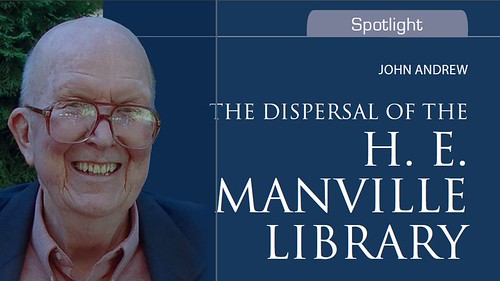
The comprehensive library of Harry Manville dedicated to the coinage of the British Isles is being sold by Douglas Saville Numismatic Books. Over half a century Harrington Elmer Manville formed one of the most remarkable numismatic libraries dedicated to the coinages of England, Scotland Ireland and the UK. It weighed over 2 tons when it was delivered from Washington DC to Caversham, a suburb of Reading in the UK.
Harry worked for the US diplomatic service, his assignments taking him to Asia and Europe as well as North America. His collecting interest was British coinage and, despite only being able to visit London infrequently prior to the final quarter of the 20th century, he formed an important collection of milled coins. In the late 1970s he found himself based in Washington and in early 1980 he retired. His important collection of coins was sold at Spink in mid-1980 (the highlight was a 1658 Cromwell sixpence that realised £10,000 hammer).
From around the mid-1970s, he laid the foundations for realising a dream: writing the Encyclopaedia of British Numismatics. From 1986 through to 2014, five volumes were published. Although he had been buying numismatic books for many years, he now started in earnest. He purchased locally from Frank and Laurese Katen in Silver Spring, MD, and of course from Douglas Saville, then manager of Spink’s Book Department in London. Although he had access to the library of the National Numismatic Collection at the Smithsonian Institution in Washington, it was not strong in material relating to the British Isles. So, he had to form his own ultimate reference library.
The result was an Aladdin’s Cave guaranteed to put the numismatic bibliophile into frenzied excitement. It contained the unique, the very rare, merely rare, the scarce, the common and the mundane. Yes, some items are highly valued in monetary terms, but others fell within the budgets of even the most modest of individuals and are not only highly interesting, but are also rarely offered. To date some 30 buyers, including institutions as well as private individuals, have purchased books from the library.
So, what are the highlights? Too numerous to list, but here are a couple. A 1770 auction catalogue for Jasper Bull’s “genuine and curious gold, silver and copper, British and Saxon coins and medals” offered at the Exchange coffee-house on March 15, 1770. Annotated in ink with the buyers and other information, it is most likely unique and is a real curiosity. Another is a limited edition—200 copies only—of Notes Gleaned from Contemporary Literature regarding 18th century Middlesex Tokens by A. W. Waters and published in 1906. This copy was owned by S. H. Hamer, the co-author of The Provincial Token-Coinage of the 18th century, by Dalton & Hamer, and is annotated in the latter’s hand. Published in 1910, it is still the standard work.
We won’t see a library like this for many years to come—if ever!
H. E. Manville publications:
(With T. J. Robertson) British Numismatic Auction Catalogues 1710–1984 (Encyclopaedia of British Numismatics Vol. I), Spink/Baldwin, London 1986.
Numismatic Guide to British and Irish Periodicals 1731–1991 (Encyclopaedia of British Numismatics Vol. II, part 1 (Archaeological)), Spink/Baldwin, London 1993.
Numismatic Guide to British & Irish Periodicals 1836–1995 (Encyclopaedia of British Numismatics Vol. II, part 2 (Numismatic)), Spink/Baldwin, London 1997.
Numismatic Guide to British and Irish Printed Books 1600–2004 (Encyclopaedia of British Numismatics Vol. III), Spink, London 2005.
Biographical Dictionary of British and Irish Numismatics (Encyclopaedia of British Numismatics Vol. IV), Spink, London 2009.
Dictionary of English Numismatic Terms (Encyclopaedia of British Numismatics Vol. V), Spink, London 2014.
Tokens of the Industrial Revolution. Foreign Silver Coins Countermarked for use in Great Britain, c. 1787–1828, Spink, London 2001 (BNS Special Publication No. 3).
Innumerable articles/papers in Spink’s Numismatic Circular, Seaby’s Coin and Medal Bulletin, British Numismatic Journal, and elsewhere.
To read the complete issue, see:
http://www.tokenpublishing.com/issue.asp?iid=406
RICHARD B. WITSCHONKE, 1945-2015
 The American
Numismatic Society is sad to announce the loss of its Curatorial Associate, Richard B. Witschonke, who passed away on 24 February 2015 in Sarasota,
Florida, at the age of 69. He was a much-loved colleague and friend of the staff, the Trustees and many of the members of the Society. We all mourn
his death.
The American
Numismatic Society is sad to announce the loss of its Curatorial Associate, Richard B. Witschonke, who passed away on 24 February 2015 in Sarasota,
Florida, at the age of 69. He was a much-loved colleague and friend of the staff, the Trustees and many of the members of the Society. We all mourn
his death.
A memorial service will be held at a later date.
Many of us here at the ANS would agree that Rick Witschonke is not only a successful businessman and a world-class collector of Roman Republican coins, but also a wonderful colleague, good friend, and a generous benefactor of the Society. The ANS was fortunate to have had Rick join its curatorial staff in 2003, first as a curatorial assistant and, from March 2006, as a curatorial associate.
Richard B. Witschonke was born in 1945 in Washington, D.C., the second oldest of five Witschonke siblings... After graduating in 1963, Rick enrolled at Bowdoin College in Maine, with a major in English. However, extracurricular activities distracted Rick from his studies and, as a result, the college suggested he “take time off and mature.” Rick started a full-time job in computer programming with a small pharmaceutical market research company. At the same time, he enrolled at the University of Bridgeport, Connecticut, where he studied part-time for three years until his graduation with a BA in English magna cum laude. In the meantime, the company where Rick worked was acquired and subsequently relocated. Rick then took a job at Perkin-Elmer, where he worked on a project involving lenses for spy satellites.
In 1972, Rick graduated from Harvard Business School with an MBA with high honors and took a position with American Management Systems, a technology consulting firm based in Washington, D. C., where he would end up working for most of his successful career in technology consulting.
In 1999, Rick was elected a member of the American Numismatic Society’s governing Council and served one term as an ANS trustee. A Life Fellow of the ANS, Rick is also a Fellow of the Royal Numismatic Society and a member of the French, Italian, and Swiss Numismatic Societies. Rick’s affiliation with the ANS, however, began much earlier. After his first visit to the ANS in the late 1960s, Rick became a member. By then, the young man had his mind firmly set on collecting Roman Republican coins.
Rick’s passion for numismatics was indirectly prompted by his paternal grandmother’s gifts of the Whitman penny boards (and coins to fill the holes) that he and his siblings received from her every Christmas. Rick was indifferent to this board-filling activity until one of his fifth-grade classmates offered to buy some of Rick’s coins for five dollars. Coin collecting did not seem so dull anymore! Excited by the profitability of this simple transaction, Rick bought his older brother’s coins for three dollars and made a handsome profit selling them to the same classmate for ten.
The first coins Rick collected were U.S.-type coins and dollar-size world coins. By the time he turned sixteen, Rick already had a few Roman Republican denarii in his collection, but his interest in these coins was intensified by the book by Rev. Edward A. Sydenham, The Coinage of the Roman Republic. The best source of information on Roman Republican coinage at the time, the book inspired Rick to learn more about the coins he decided to collect. Republican denarii, beautiful coins of uniform size, were affordable for a young collector, and there were so many rare and interesting types that one could never hope to complete the full series. What more could a true numismatist want?
Another important event that influenced Rick as a coin collector was his meeting with Charles Hersh, a prominent banker and numismatist who, on a Fulbright scholarship in London, helped G. C. Haines and L. Forrer edit Sydenham’s volume. Rick’s meeting with Hersh happened at the coin auction of the Thomas Olive Mabbott collection (sold by Hans Schulman) at New York City’s Waldorf-Astoria hotel in 1969. They struck up a conversation that resulted in a long and productive friendship. In 1998, Rick sponsored a Festschrift in honor of Charles Hersh’s seventy-fifth birthday. The volume was edited by Andrew Burnett and Ute Wartenberg and presented to Charles in June 1998, just six months before his untimely death. Rick numbers among his friends many prominent coin collectors, dealers, scholars, and curators: Bill Metcalf, Alan Walker, Basil Demetriadi, Michel Amandry, and Andrew Burnett, among many others. Rick has always made his collection available for study by serious scholars of numismatics and by fellow collectors. For example, a number of provincial coins from his collection were published in RPC I. Rick thoroughly enjoys meeting the many numismatic scholars who visit the ANS each year.
This is a sad day for numismatics. Richard B. Witschonke died on 24 February 2015 in Sarasota, Florida. That leaves us speechless. Rick died unexpectedly and far too soon. He leaves a great void in the numismatic community.
Besides numismatics, Rick was a wonderful person, always interested in the person he was dealing with. With pleasure I recall all our conversations, the many emails we exchanged, the invitations at regular intervals – on both sides – which we could never get back to, for lack of time and due to the great distance. Rick has supported CoinsWeekly from the very beginning. He kept sending links and information he deemed important to the numismatic community.
Mark writes:
I am tentatively planning to write and submit a short obituary for Rick Witschonke to World Coin News. To have it published in the next issue is my goal. But this would mean that I would need to have my work done by March 5th. If any readers of The E-Sylum have any photos they would like to share of Rick, or anecdotes of his early or later life, I would be sincerely grateful to incorporate some of them in my work, if there is room. Those interested can e-mail me directly at marktfox@gmail.com.
To read the complete articles, see:
Press Release - ANS - Witschonke
(http://numismatics.org/NewsEvents/PR20150225RWitschonke)
The American Numismatic Society Staff Profiles: Rick Witschonke
(http://ansmagazine.com/Winter06/Witschonke)
Richard B. Witschonke (1945-2015) (http://coinsweekly.com/en/News/4?&id=3296)
NOTES FROM E-SYLUM READERS: MARCH 1, 2015
A Washington Double Head Cent Find
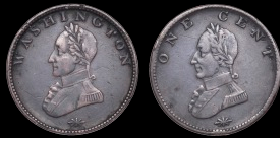 David Pickup writes:
David Pickup writes:
I found a Washington double head cent in my local dealer's rubbish tin on Saturday. Similar to the attached one though not quite so good condition.
Dave Alexander on the Blizzard of 1957
Dave Alexander writes:
Great memoir by Harvey Stack about the blizzard of 1957. When that storm hit I was attending third grade at Saint Gregory the Great school in Brooklyn. Had just gotten a collecting nudge from a small group of Indian Head Cents from Joe and Al's Fish Market on Kingston Avenue but would not really start collecting for two more years and that in Miami. Harvey has a marvelous memory.
To read the earlier E-Sylum article, see:
THE SCHMANDT SALE AND THE BLIZZARD OF 1957 (www.coinbooks.org/esylum_v18n08a19.html)
Joseph Barnet Obituary
Rick Stroman writes:
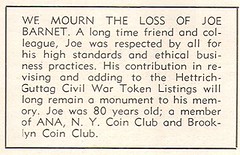 I found
a brief obit on Joe Barnet on the last page of Abe Kosoff's Numismatic Gallery Monthly Jan. 1949 issue.
I found
a brief obit on Joe Barnet on the last page of Abe Kosoff's Numismatic Gallery Monthly Jan. 1949 issue.
To read the earlier E-Sylum article, see:
MORE ON JOSEPH BARNET (www.coinbooks.org/esylum_v18n08a09.html)
Binion's Current $Million Display
Chriss Hoffman writes:
 I was interested in the Binion's Million dollar display. I had a photo taken with the original
horseshoe display full of $10,000 bills. I looked up the current display and I found a page on Binion's site where they offer a photo opportunity
for free daily with the $million dollar display. Nowhere near as an effective display as the old horseshoe full of $10K notes.
I was interested in the Binion's Million dollar display. I had a photo taken with the original
horseshoe display full of $10,000 bills. I looked up the current display and I found a page on Binion's site where they offer a photo opportunity
for free daily with the $million dollar display. Nowhere near as an effective display as the old horseshoe full of $10K notes.
To see the current Binion's display, see:
TAKE YOUR PHOTO FREE WITH ONE MILLION DOLLARS
(www.binions.com/million_dollar_photo.php)
To read the earlier E-Sylum article, see:
NOTES FROM E-SYLUM READERS: FEBRUARY 22, 2015 : Binion’s Horseshoe Casino $10,000 Notes
(www.coinbooks.org/esylum_v18n08a10.html)
An Evening at the Fed
American Numismatic Association Numismatic Instructor Sam Gelberd writes:
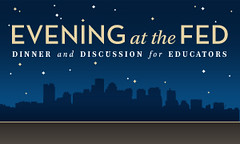 I just wanted to add that I was at the Denver Branch of the Kansas City
Federal Reserve Bank a few months ago for something called, “An Evening at the Fed.” This is a dinner held for professionals within the education
community (i.e., teachers) and they not only provide dinner for these educators, but also a lot of materials that could be useful in the classroom to
facilitate lessons – and this is available at NO cost to the teachers!
I just wanted to add that I was at the Denver Branch of the Kansas City
Federal Reserve Bank a few months ago for something called, “An Evening at the Fed.” This is a dinner held for professionals within the education
community (i.e., teachers) and they not only provide dinner for these educators, but also a lot of materials that could be useful in the classroom to
facilitate lessons – and this is available at NO cost to the teachers!
The FED also provides lecturers to inform teachers about recent goings-on within the economic community at these dinners, and they also give a brief tour of their money museum. It doesn’t matter how much collecting experience a teacher has – this is primarily conducted to provide materials for teachers to enhance their lesson plans, whether they are economic, historical, et cetera in nature.
Please tell as many K-12 teachers as you can; no sense in hiding this “secret” about the FED from them! Click on the following link for additional information about this dinner (held once a year at various FED facilities; I’ve also attend this at the Atlanta Fed Branch in Miami, FL.) : http://www.kc.frb.org/events/eventdetail.cfm?event=8D5EB967737EEB1BF73C37ED1EFE1D6D
To read the earlier E-Sylum article, see:
"SECRETS" OF THE DENVER FEDERAL RESERVE
(www.coinbooks.org/esylum_v18n08a11.html)
J.K. Lilly Medal
Describing a lot found on eBay, Alan V. Weinberg writes:
I hadn't seen this J.K. Lilly medal before. It joins ranks of other OLD medals depicting major numismatists: Elder, Boyd, Mickley, Farouk, Curto and Fuld.
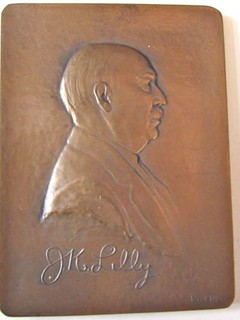
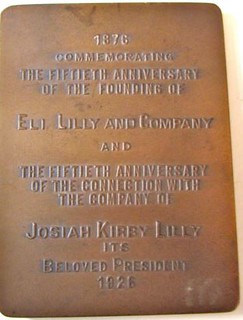
To read the complete eBay lot description, see:
BRONZE MEDAL, J.K.LILLY
1876-1926 FIFTIETH ANNIVERSARY-MARKED KILENYI
(www.ebay.com/itm/BRONZE-MEDAL-J-K-LILLY-1876-1926-FIFTIETH-ANNIVERSARY-MARKED-KILENYI-/251845171609)
CryptoLabs Developing Bitcoin Wallet
Stephen Schultz, who co-founded Pictometry International almost 20 years ago, has been named chief technology officer for CryptoLabs, a fast rising startup company at Rochester Institute of Technology's Venture Creations business incubator.
The company is developing a bitcoin wallet, a sophisticated piece of hardware the size of a credit card that allows users to send and receive digital currency.
To read the complete article, see:
Pictometry co-founder joins high tech startup
(www.democratandchronicle.com/story/money/2015/02/23/bitcoin-wallet-cryptolabs-cryptocurrency-pictometry-stephen-schultz-melanie-shapiro-digsby/23905067/)

Archives International Auctions, Part XXIII
U.S. and Worldwide Banknotes, Security Printing Ephemera and U.S. Federal Bonds and Documents.
Highlights include:
- Possibly Unique As Issued 1866 Gold Coin Note
- Spectacular American Bank Note Co. Advertising Sheet in Spanish
- United Arab Emirates Currency Board, 1973
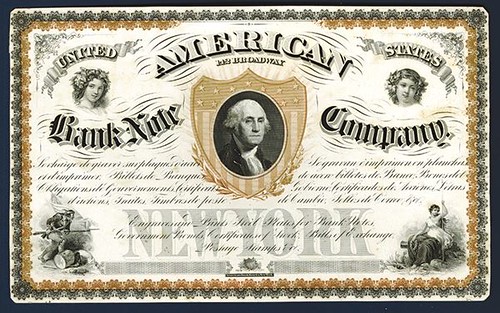
1580 Lemoine Avenue, Suite #7
Fort Lee, NJ 07024
Phone: 201-944-4800
Email: info@archivesinternational.com
WWW.ARCHIVESINTERNATIONAL.COM
KUZNETS 1971 NOBEL MEDAL SELLS FOR $390,848
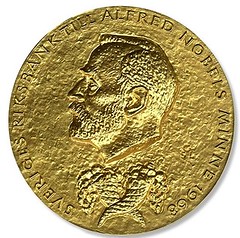 The 1971 Nobel Prize in Economic Sciences awarded to Gross Domestic Product (GDP) inventor Simon Kuznets
sold tonight for $390,848 at Nate D. Sanders Auctions. It was the first Nobel Prize in Economic Sciences to ever be auctioned and only the sixth
Nobel Prize to ever go under the hammer. Interested bidders may participate in the auction online.
The 1971 Nobel Prize in Economic Sciences awarded to Gross Domestic Product (GDP) inventor Simon Kuznets
sold tonight for $390,848 at Nate D. Sanders Auctions. It was the first Nobel Prize in Economic Sciences to ever be auctioned and only the sixth
Nobel Prize to ever go under the hammer. Interested bidders may participate in the auction online.
Unlike other famous economists, Kuznets utilized demography and statistics to infer the effects of population growth on national productivity. He authored important studies that quantified economic activity and its relationship to population increases, and immigration and internal population shifts. During World War II, his research at the Bureau of Planning and Statistics, War Production Board was instrumental in providing realistic estimates of national productivity for the defense effort.
Kuznets pioneered the Gross Domestic Product concept for a Congressional report in 1934. After the 1944 Bretton Woods conference, GDP became the primary tool for measuring a nation’s economic productivity. Kuznets also developed a macroeconomics-based measurement system, which the Commerce Department uses to estimate the gross national product The World Bank and private economists adapted Kuznets’ system to estimate economic growth in industrial and third-world countries.
The gold medal bears Alfred Nobel’s image and the engraving ''Sveriges Riksbank Till Alfred Nobels Minne 1968” on one side. The medal’s reverse side features the Royal Swedish Academy of Sciences’ north star emblem with the engraved phrase “Kungliga Vetenskapsakademien.'' “Simon Kuznets 1971” is engraved on the medal edge. The medal is displayed in the original red leather case with Dr. Kuznets’ name gilt stamped.
To read the complete article, see:
Gross
Domestic Product inventor Simon Kuznets' 1971 Nobel Prize sells for $390,848
(http://artdaily.com/news/76792/Gross-Domestic-Product-inventor-Simon-Kuznets--1971-Nobel-Prize-sells-for--390-848#.VPG1ivkVi5U)
To read the earlier E-Sylum article, see:
THE SIMON KUZNETS 1971 NOBEL ECONOMIC SCIENCES MEDAL
(www.coinbooks.org/esylum_v18n08a13.html)
ARTICLE HIGHLIGHTS NATIONAL BANK NOTE HISTORY
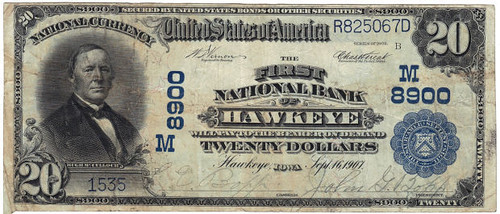
Retrieve some folding money from a bank in Iowa these days and the bills, except for a few numbers, will look exactly like those picked up in another state or on far sides of the United States.
That wasn't always the case. In fact, from 1863 to 1935 -- a period of more than 70 years -- bills from different communities and even competing banks bore a striking difference. Each could carry the name of its city in prominent letters and required signatures of bank officials representing the financial institutions.
According to the Federal Reserve, Congress passed the National Banking Act at the height of the Civil War. The goal was to establish a national banking system and, by extension, a uniform currency.
With the National Banking Act, financial institutions even in very small towns, if they purchased U.S. government securities, could issue their own banknotes.
And they did.
Iowa wound up with 496 national banks in 301 towns, each issuing their own currency. Waterloo, for instance, had six national banks. Cedar Falls had three.
Garrett's auction Feb. 28 will include banknotes issued in Iowa, including a rare beauty from the First National Bank of Hawkeye in 1907. The Peoples National Bank of Independence and First National Bank of Independence are also represented.
Logically, a bank in a large city would issue more currency. The Levitt & Johnson National Bank of Waterloo was the leader in the metro area, distributing slightly more than $3 million from 1898 to 1932.
"The banknotes were printed in Washington, D.C., and mailed to the banks, where they were signed by the cashier and president of each bank," according to Garrett.
"Because it was commonplace and just a part of everyday life, very few people thought to save these banknotes. Today many of them are extremely rare and worth thousands of dollars to the collectors who specialize in them," he adds.
The First National Bank of Hawkeye had $319,570 printed from 1907 to 1933. The Hawkeye cash came in nine types and denominations.
But again, the remaining stock is very small. Of the vintage Hawkeye money, the survivors are two $20 bills, four $10 bills and eight $5 bills, according to Garrett.
"Iowa is kind of the national birthplace of banknote collecting," he says.
Two men in particular set the standards that govern the trade. John Hickman and Dean Oakes were based in Iowa City and made sales from 1976 to 1989. According to some sources, even their catalogs are now deemed collectible.
Hickman found a friend in fellow collector William Higgins Jr., described as a man with means. Hickman helped Higgins assemble a collection, which in 1978 became the Higgins Museum of National Banknotes in Okoboji.
The collection today features bills from 278 Iowa towns representing each of the state's 99 counties.
Higgins was a contemporary and friend of Ronald Reagan. So besides banknotes, the museum's collection includes an antique "spider" currency printing press, a display arranged for Higgins by President Reagan.
To read the complete article, see:
Rare
Hawkeye banknote going on auction block
(http://wcfcourier.com/news/local/rare-hawkeye-banknote-going-on-auction-block/article_818f12b9-3244-56a0-9c81-d6eb8834bac6.html)
For more information about the Higgins Museum, see:
www.thehigginsmuseum.org
KNIGHTS OF PYTHIAS ORPHANAGE MEDAL
Jerry Adams writes:
There is a medal from Texas that does not have the words "orphan" or orphanage on it. It is from Weatherford, Texas and the home opened in 1909 and was backed by the Knights of Pythias fraternal organization.
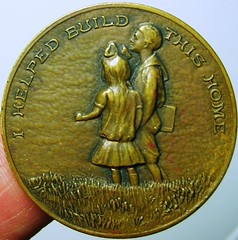
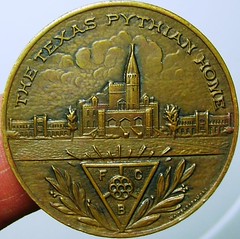
To read the complete article, see:
Weatherford, Texas (Parker County), U.S.A.
(http://tokencatalog.com/token_record_forms.php?action=DisplayTokenRecord&td_id=100065)
For more information on the Texas Pythian Home, see:
https://pythianhome.org/History.html
To read the earlier E-Sylum article, see:
MORE ON ORPHANAGE TOKENS (www.coinbooks.org/esylum_v18n08a21.html)
WWI LALIQUE ORPHANAGE PIN BADGE
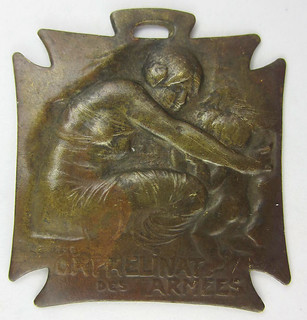 Mother and small NUDE Children to right, being gathered-in by woman
Mother and small NUDE Children to right, being gathered-in by woman
Orphelinat des Armes
SIGNED "LALIQUE" above bottom inscription, to left.
The Orphan Army - Probably a receipt for a donation to the orphans of WW I.
The famous Rene Lalique was born in 1860. During the period 1882-1900 he gained eminence as a jewelry designer. In 1900 he receives the prestigious award "Croix de Chevalier de la Legion d'Honneur"
Thin bronze pin or badge, uniface (one sided, reverse incuse), 30mm wide.

SHORT SNORTERS TO PROMOTE PORTLAND ANA SHOW
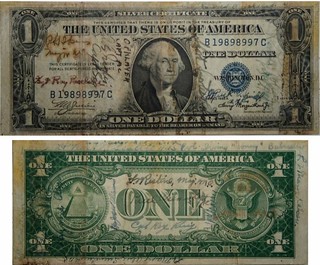 Thomas Sparks,
the founder of the Short Snorter Project and a member of the American Numismatic Association, will drop eight vintage blue seal U.S. $1 silver
certificate Short Snorters into circulation in Portland during the 2015 National Money Show, to be held March 5-7 at the Oregon Convention
Center.
Thomas Sparks,
the founder of the Short Snorter Project and a member of the American Numismatic Association, will drop eight vintage blue seal U.S. $1 silver
certificate Short Snorters into circulation in Portland during the 2015 National Money Show, to be held March 5-7 at the Oregon Convention
Center.
Sparks will drop four Short Snorter notes into circulation on Wednesday, March 4, the day before the show opens. He will drop another four into circulation on Friday, March 6.
A Short Snorter is a banknote that has been signed by people traveling together by aircraft. The tradition began in the 1920s with Alaskan bush pilots and spread through military and commercial aviation, especially during World War II. The term "short snort" means less than a full shot of liquor, a joke among pilots who knew the dangers of mixing aviation and alcohol.
Of the eight Short Snorters that will be dropped into circulation, one of them is signed by Red Skelton, a comedian and clown who was part of several United Service Organization (USO) tours during World War II.
"I wish to bring attention to the Short Snorter tradition and provide a means to educate the public about these artifacts brought home by brave men and women who served our country," Sparks said. "The Short Snorter Project is dedicated to those who fought for our freedom. Many of those folks did not live to tell their own story. I would like future generations to understand Short Snorters and keep the memories alive."
Sparks will be promoting Short Snorter notes throughout the show. He will give a Money Talks presentation at 11 a.m. Saturday, March 7, titled "The Short-Snorter Project: Still Keeping the Memories Alive" in Room E144. He will also exhibit a collection of Short Snorters at the show.
To read the complete press release, see:
Short Snorter notes dropping prior to Portland National Money
Show (http://admin.listpilot.net/mpower/showHtml.do?ac=money&id=9mac35y_ae77b2c2)
COSTA RICA NOTES AT LYN KNIGHT 2015 CPMX SALE
The CPMX auction continues the Lyn Knight Currency Auctions tradition of selling the best collections from Costa Rica. These notes are being offered this Thursday night, March 5 with the auction beginning at 5:00 PM Central Time. Lots can be viewed and bids made at www.lynknight.com
Here are five terrific notes from Costa Rica:
LOT 227: a sensational original; very tough type in stellar condition

LOT 234: eminently collectible highest denomination of series
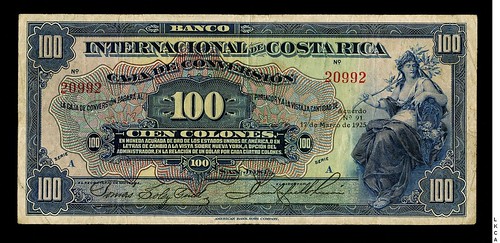
LOT 250: the fourteenth note made for this type in terrific condition
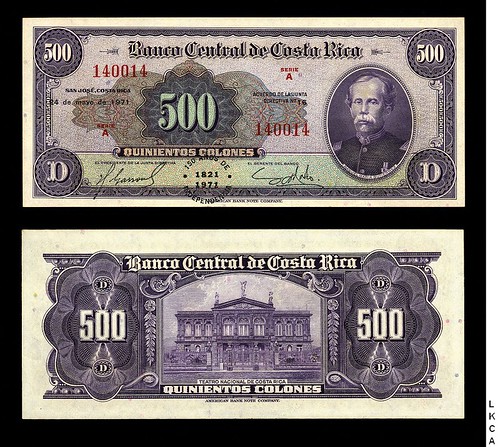
LOT 255: polymer for type never issued as such; rarely offered
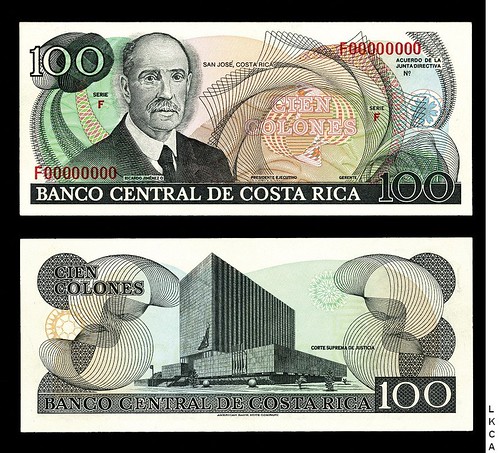
LOT 267: rare ISSUED example for type that essentially only shows as a remainder
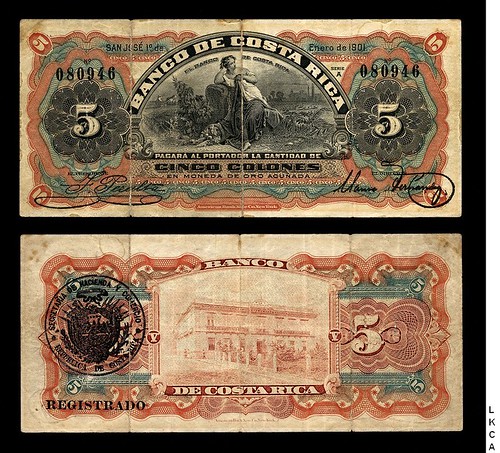
ROYAL MINT UNVEILS NEW LIKENESS OF BRITANNIA
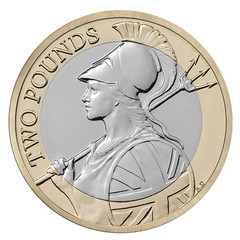 We are delighted to announce that Britannia is to return to the circulating
coinage, on the new definitive £2 – she hasn’t been struck on circulating coins since 2008!
We are delighted to announce that Britannia is to return to the circulating
coinage, on the new definitive £2 – she hasn’t been struck on circulating coins since 2008!
The new depiction of Britannia will replace Bruce Rushin’s ‘History of Technological Achievement’ design that has been a constant feature on the £2 coin since its first issue in 1997.
The Romans were the first to use Britannia as a personification of the island of Britain. It’s an association that dates back to the reign of Emperor Hadrian, who visited Britain in AD 119. However, her history on Britain’s coinage is somewhat shorter, as it wasn’t until 1672 during the reign of Charles II that Britannia first featured on Britain’s coins. For over 300 years, Britannia remained a permanent feature of the coinage, gracing the coins of every British monarch from 1672 until 2008 – when Britannia was last struck on circulating coins.
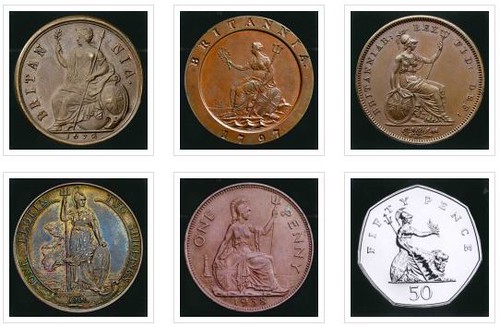
Britannia’s long-awaited return to the coinage is truly historic, and the new design by Anthony Dufort features Britannia as we have never seen her before! It has a contemporary and modern feel, with a cropped portrait displaying only the head and shoulders of Britannia – a departure from the traditional seated pose and the familiar defiant stance on bullion coins. However, her heritage remains: both the trident and shield clearly feature in the design, and Britannia is seen wearing a Corinthian helmet.
David Pickup writes:
Not sure what to think of it. It is interesting as a design but nothing like as good as the traditional designs on the penny!
Pabitra Saha writes:
Finally, the UK has decided to go in for new reverse design for 2 Pounds coin, which it skipped while issuing the new "Coat of Arms jigsaw" series in 2008. The old design was issued for the first time in 1997. The tradition of not indicating denomination in numeric form was started with this coin. Hopefully, the year will be indicated on the obverse (and not skipped). The chance of redesigning the coin in shape and size has also been not availed.
Hopefully, the Royal mint will avoid the temptation of minting this coin with the old effigy of the queen, to create some rare coins and hence some easy profiteering. The new effigy will be announced in two - three days.
To read the complete article, see:
Britannia returns to circulating coins!
(http://blog.royalmint.com/britannia-returns-circualting-coins/)
ROYAL MINT: COINS THAT NEVER WERE
Chip Howell writes:
Designing Britain’s decimal coins began in 1961, far earlier than you may imagine.
The Royal Academy, the Royal Institute of British Architects, the Faculty of the Royal Designers for Industry and the Royal College of Art were invited to nominate artists to submit designs for a new decimal currency. Christopher Ironside was one of the talented individuals invited to submit designs as part of a combined Royal Designers for Industry/Royal College of Art team.
The team were fortunate enough to win the competition, and Ironside’s designs were chosen to be taken forward.
Christopher Ironside worked tirelessly to produce designs fit for Britain’s national coinage. His wife, Jean, wrote an evocative tale describing the sacrifice and dedication that went into creating the designs in total secrecy at their home. This continued for 5 long years until, in 1966, Ironside was summoned to the Mint to be given the news that the Chancellor of the Exchequer, James Callaghan, was about to announce that Britain’s new decimal coins would be designed through a new open competition.
Ironside was effectively sent back to the drawing board, but he didn’t give up and worked even harder to produce a set of designs that would win the competition outright. This resulted in the coins that introduced Britain to decimal currency and which would cement Ironside's place in history.
For the first time, we are able to reveal the designs Ironside originally produced. The working drawings and moulds can be found at The British Museum while the coins themselves are held at The Royal Mint Museum.
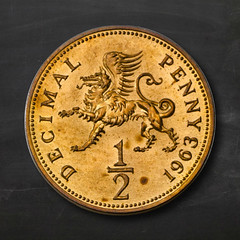
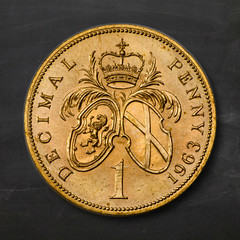
The half penny coin features a Welsh dragon.
The one penny coin features a Scottish theme
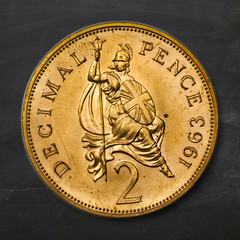
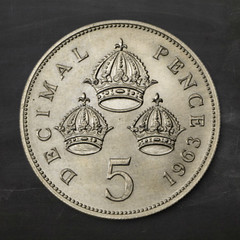
The two pence coin features Britannia.
The five pence coin features three crowns.
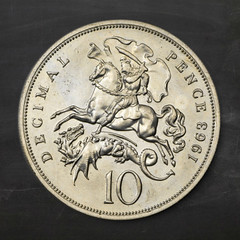
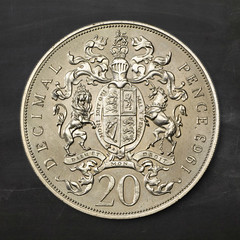
The ten pence coin features St George and the dragon
The twenty pence coin features the Royal coat of arms
To read the complete article, see:
Designing Britain’s decimal coins began in 1961, far earlier than
you may imagine (www.royalmint.com/discover/decimalisation/unseen-ironside-designs)
THE BOOK BAZARRE
ROMAN PROVINCIAL COIN ATTRIBUTIONS SUGGESTED
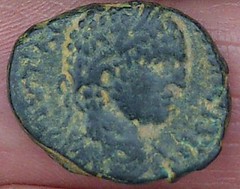
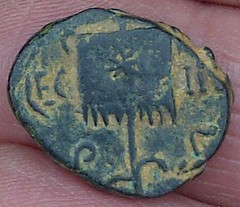
Javier Arce, Prof. Emeritus Roman Archaeology, University Lille3 (France) writes:
In my opinion, it is clearly a labarum and therefore, the coin should be Constantinian (after 313 AD). In the portrait, we can see also the diadem, that is clearly also Constantinian. The mention of the Legio Tertia is not so unusual in some issues in bronze in the period.
On our Flickr photo archive, Stuart writes:
Caracalla?
Aren't Roman provincials fascinating? I didn't quite expect to be making a contribution of this nature for The E-Sylum, but here it goes...
The bronze in question is an issue of Rhesaena (today's Ra's al-'Ayn, Syria) in the Roman province of Mesopotamia (part of modern Iraq, Syria, and other countries), struck for the emperor Caracalla (AD 198–217). The Roman provincial coinage of Rhesaena contains some of the crudest coins struck under the Romans that I have ever seen, especially those minted during the reign of Caracalla's numismatic twin, Elagabalus (AD 218–222). Engravers aglow with talent by comparison were responsible for cutting most of the dies under later emperors, particularly Trajan Decius (249–251).
David's coin is in remarkably good condition with a clear reverse and good centering on both sides, despite the irregular flan. The reverse appears to read "LEG III / P S," probably referring to Legio III Parthica, the Roman legion that was stationed at Rhesaena.
Here is a similar example with the letter 'Γ' on the vexillum.
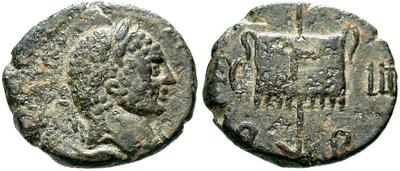
http://www.acsearch.info/search.html?id=9508
The legends might also differ slightly in their content. They are almost always hard to read on the early coins, even on the best preserved specimens.
For the star-on-vexillum variety (as in David's example), we have these two specimens in the online BnF database:
http://catalogue.bnf.fr/ark:/12148/cb417437260/PUBLIC
http://gallica.bnf.fr/ark:/12148/btv1b8473954k
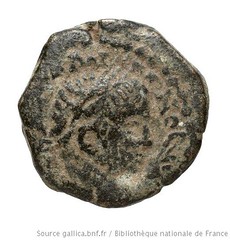
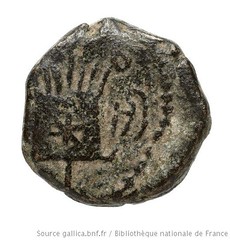
http://catalogue.bnf.fr/ark:/12148/cb41847296x/PUBLIC
http://gallica.bnf.fr/ark:/12148/btv1b103134133
They illustrate the carelessness and/or inexperience of both engraver and minter, and the difficulty of interpreting these coins because of these problems. The reverse of the second coin, for instance, is pictured upside down!
For a wider view of the coinage, I recommend having a peek at the Rhesaena web page on Wildwinds:
http://www.wildwinds.com/coins/greece/mesopotamia/rhesaena/t.html
 I think the principal reference on this city's coins is still The Coinage of Rhesaena
in Mesopotamia (1946), by Karel O. Castelin (ANS NNM #108). I was quite surprised during my research of David's coin to have found a
digitized copy of Castelin's work online, courtesy of HathiTrust!
I think the principal reference on this city's coins is still The Coinage of Rhesaena
in Mesopotamia (1946), by Karel O. Castelin (ANS NNM #108). I was quite surprised during my research of David's coin to have found a
digitized copy of Castelin's work online, courtesy of HathiTrust!
http://catalog.hathitrust.org/Record/001668060
If someone needs help, I probably could dig up a catalog reference from this monograph for David's coin, or at least the listed type that it most closely resembles. Hope this helps.
David Pickup writes:
Please pass on my thanks to Mark for this. I appreciate the work he has put into this. I certainly found it a challenging coin! I agree with the Rhesaena link.
To read the earlier E-Sylum article, see:
QUERY: ROMAN PROVINCIAL COIN ATTRIBUTION SOUGHT
(www.coinbooks.org/esylum_v18n08a17.html)
MINT OF POLAND STRIKES SPHERICAL COIN
 New coinage production techniques developed by the Mint of Poland make striking the world possible.
New coinage production techniques developed by the Mint of Poland make striking the world possible.
The Mint of Poland has unveiled new technology allowing for the creation of spherical (globe-shaped) coins. The technology was announced in a presentation Jan. 29 during the technical forum preceding the World Money Fair in Berlin
Siemowit Kalukiewicz, the chief operating officer of the Mint of Poland, unveiled the 2015 Seven New Wonders of the World 7-ounce .999 fine silver $7 coin during the forum.
This commemorative coin was struck by the Mint of Poland, which issued it in the name of Niue Island, a territory of New Zealand.
The coin features a design based on the 1638 hand-drawn world map Nova totius terrarum orbis geographica ac hydrographica tabula created by eminent Dutch cartographer Willem Janszoon Blaeu. The map is in the collection of the Boston Public Library.
To create a spherical coin, the Mint of Poland first prepared and evaluated a three-dimensional-model of the coin using Delcam’s modelling software ArtCAM. To assure the coin’s ideal spherical shape and map the images, engineers created a special six-piece die setup, with hammer (top) and anvil (bottom) dies joined with four collar dies on the sides.
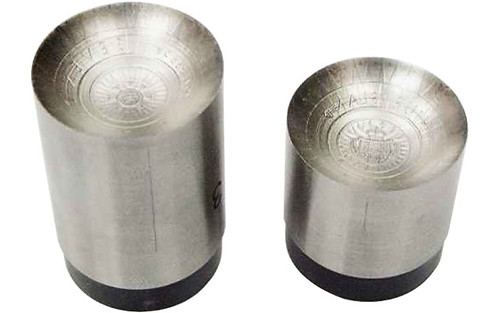
According to Kalukiewicz, mint technicians first used blank dies to strike test examples in copper. Then technicians struck copper and silver test strikes with dies bearing designs, learning that perfectly round blanks would not result in perfectly round coins.
The planchets were given a slightly raised, ridged area at the upper pole. This was necessary so the globular shape remained intact when the hammer die struck the planchet. It allowed the metal to flow just where the mint technicians needed it, to produce the spherical shape of the final product.
Kalukiewicz said it required 13 hours to laser-engrave each of the four pieces of the collar (for a total of 52 hours) used in striking this revolutionary new coin, and dozens of hours were needed to laser-engrave the hammer and anvil dies.
Two strikes from the press were needed, the first strike using 600 kilonewtons of force and the second strike using 650 kilonewtons of force.
To read the complete article, see:
Polish mint goes global with groundbreaking
coin shape (www.coinworld.com/insights/polish-mint-goes-global-with-groundbreaking-coin-shape-.html)
FOUNTAINS ABBEY SETTLERS LABOR EXCHANGE TOKEN
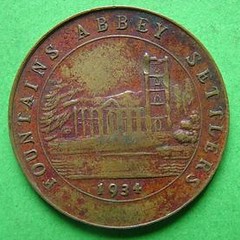

Following on from last week's email about unusual social history experiments and the token issues resulting, herewith one from a communal self-help group where the denomination of the coin is not monetary but a unit of labour; indeed, the wording on the reverse specifically states that the piece has no cash value.
The Fountains Abbey Settlers experiment at Swarland, Northumberland, in the 1930s was an attempt to productively resettle a group of unemployed Tyneside craftsmen in a new, specially-created rural community some 25 miles to the north. There are a number of descriptions of it online, of which the quote below is probably one of the best. Others may be found by Googling the name of the innovator, Commander Clare Vyner.
By 1934 the central portion of the {Swarland} estate was bought by Clare Vyner, of Studley Royal, Ripon, for development by the Fountains Abbey Settlers’ Society Limited as a land settlement for unemployed tradesmen and their families from Tyneside.
Since the end of the 19th century, land settlement had been seen as a way of providing smallholdings for men anxious to carve out for themselves a life of agriculture in the countryside, and by the mid 1930s as a partial answer to unemployment. Thus there were many land settlements throughout the country and, indeed, throughout Northumberland, but all had been provided by local authorities and by public money. Swarland was different. Funded entirely by private subscription, and designed by Miss Molly Reavell, there were 54 smallholdings built, each with an acre and a half of land. Sixteen other houses were provided, together with three shops, a magnificent sports field with tennis courts and bowling green, and a large, superbly equipped village hall. The families who came were all tradesmen who had been out of work for some time. Work was provided for them at the Swarland brickworks at Thrunton, the Swarland sawmills and joinery at Amble and the Swarland tweed mills on the estate, where beautiful Cheviot tweeds and Harris tweed, under licence, were woven.
 77
homes were reputedly built, and an example of unaltered one is illustrated, with a bit of background, in the sales advert referenced below. It is
likely that the would-be occupants pooled their skills to assist with the building and repairing of each others' accommodation, and maybe other
manual tasks such as gardening as well, with these tokens being the medium of exchange through which they did so.
77
homes were reputedly built, and an example of unaltered one is illustrated, with a bit of background, in the sales advert referenced below. It is
likely that the would-be occupants pooled their skills to assist with the building and repairing of each others' accommodation, and maybe other
manual tasks such as gardening as well, with these tokens being the medium of exchange through which they did so.
I have never seen another specimen, and so have no idea whether there are other denominations or dates. I am inclined to suspect not.
To read the complete articles, see:
Swarland in Northumberland goes online with new
website (http://alnmouthvillage.co.uk/swarland-in-northumberland-goes-online-with-new-website)
Nelson Drive, Swarland, Northumberland
(www.heritage-explorer.co.uk/web/he/searchdetail.aspx?id=7428&crit=plan)
To read the earlier E-Sylum articles, see:
MORE ON ORPHANAGE TOKENS (www.coinbooks.org/esylum_v18n08a21.html)
TOKENS FROM HOMES FOR INEBRIATES (www.coinbooks.org/esylum_v18n08a22.html)
THE BOOK BAZARRE
1964 COMIC ABOUT COINS AND COLLECTORS
In an email chain this week, Dennis Tucker writes:
Paging Eva Adams! A childhood chum sent me this fascinating comic strip yesterday. What a hoot!
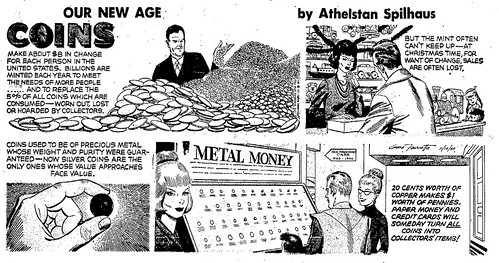
Dennis's friend writes:
According to this info-graphic, someday soon (possibly as soon as the year 2000!) ALL coins will be collector’s items.
There’s a lot to love in this. The idea that, in 1964, the economy was on the verge of grinding to a halt because the girl at the cash register at Macy’s didn’t have four pennies. The completely random Woman of the Future in the lower right panel. The implication that coin collectors are selfishly imposing a massive burden on the rest of us. (Darn you numismatists!!!!)
Joel Orosz chimed in:
First, can we all agree that there is no better--indeed, could be no better--name for a cartoonist than the redoubtable "Athelstan Spilhaus"? His first name conjures the glories of ancient Athens, and his last evokes a German public comfort station!
Be that as it may, Herr Spilhaus may not be too far off in his prediction of doom for "metal money," as various electronic forms of payment continue to proliferate. But, in the last frame, heaven forfend that the future will witness a return of the bushy-bushy bun hairdo and cat's-eye glasses!
Thanks for sharing this delightful bit of prognostication!
VINT CERF PROPOSES 'DIGITAL VELLUM' TO PRESERVE ELECTRONIC WORKS
A leading light of the Internet is worried that the time is rapidly approaching when email, photos, documents and other digital relics may be lost to history because the tools needed to view them are becoming obsolete.
Vint Cerf, a Google vice president who is credited with nursing Internet development from its beginnings as a defense research project, said we risk entering a “dark age,” when digital objects could become lost because software needed to access them no longer exists.
In a recent talk at the American Association for the Advancement of Science’s annual meeting in San Jose, Cerf called for the development of “digital vellum,” a way to maintain support for technology that could open original files regardless of their age.
“We don’t want our digital lives to fade away,” Cerf told the conference. “If we want to preserve them, we need to make sure that the digital objects we create today can still be rendered far into the future.”
The cost of not addressing the issue would be painful, he warned. “When you think about the quantity of documentation from our daily lives that is captured in digital form, like our interactions by email, people’s tweets and all of the world wide web, it’s clear that we stand to lose an awful lot of our history.”
Cerf is backing a plan to take an X-ray snapshot of the content, the application and operating system, together with a description of the machine that it runs on and store the information in the cloud in perpetuity.
That snapshot “will recreate the past in the future,” he said, by preserving both the data and technical specs necessary for future users to access the data and recreate the image.
"The key here is when you move those bits from one place to another, that you still know how to unpack them to correctly interpret the different parts. That is all achievable if we standardize the descriptions,” Cerf said at the conference.
A version of Cerf’s digital vellum has been tried at Carnegie Mellon University by Mahadev Satyanarayanan, a professor of computer science, with the support of IBM Corp.
The system, called Open Library of Images for Virtualized Execution or OLIVE, aims to preserve digital information as executable content, by "freezing" and reproducing the execution state that generates the information, according to a report on NewsFactor.
“An increasing fraction of the world’s intellectual output is in the form of executable content,” according to a description of the project, and that includes simulation models, tutoring systems, expert systems and data visualization tools.
Using OLIVE, researchers have already archived the Mystery House, the original 1982 graphic adventure game for the Apple II, an early version of WordPerfect and Doom, the original 1993 first person shooter game.
The Library of Congress has its own solution for long-term preservation of its collection.
The LOC recently recommended formats for long-term preservation of a range of works, including textual documents, musical compositions, still images, audio, moving images, software and electronic gaming as well as datasets and databases.
“The Library’s mission is not simply to collect the extraordinary and diverse creative content of the American people and from around the world, but to make sure the collections are available and accessible for many generations to come," said Roberta Shaffer, association librarian for Library Services.
To read the complete article, see:
How to avoid the coming ‘dark age’ for digital records
(http://gcn.com/articles/2015/02/19/digital-dark-ages.aspx)
ISIS DESTROYS MOSUL PUBLIC LIBRARY
While the world was watching the Academy Awards ceremony, the people of Mosul were watching a different show. They were horrified to see ISIS members burn the Mosul public library. Among the many thousands of books it housed, more than 8,000 rare old books and manuscripts were burned.
“ISIS militants bombed the Mosul Public Library. They used improvised explosive devices,” said Ghanim al-Ta'an, the director of the library. Notables in Mosul tried to persuade ISIS members to spare the library, but they failed.
The former assistant director of the library Qusai All Faraj said that the Mosul Public Library was established in 1921, the same year that saw the birth of the modern Iraq. Among its lost collections were manuscripts from the eighteenth century, Syriac books printed in Iraq's first printing house in the nineteenth century, books from the Ottoman era, Iraqi newspapers from the early twentieth century and some old antiques like an astrolabe and sand glass used by ancient Arabs. The library had hosted the personal libraries of more than 100 notable families from Mosul over the last century.
During the US led invasion of Iraq in 2003, the library was looted and destroyed by mobs. However, the people living nearby managed to save most of its collections and rich families bought back the stolen books and they were returned to the library, All Faraj added.
Iraq, the cradle of civilization, the birthplace of agriculture and writing and the home of the Sumerian, Akkadian, Assyrian, Babylonian and Arab civilizations had never witnessed such an assault on its rich cultural heritage since the Mongol era in the Middle Ages.
To read the complete articles, see:
ISIS Burns 8000 Rare Books and Manuscripts in Mosul
(http://finance.yahoo.com/news/isis-burns-8000-rare-books-030900856.html)
8,000 Books Burned by ISIS in Massive Iraqi
Libricide (http://news.artnet.com/art-world/8000-books-burned-by-isis-in-massive-iraqi-libricide-267932)

ARGENTINA'S NEW BANKNOTE RILES FALKLAND ISLANDERS

Argentina's redesign of their 50 peso note to include the Falklands has been mocked by residents of the islands.
The new bank note will go into circulation next month, Alejandro Vanoli, president of the central bank, announced on Monday. The design of the note was unveiled last year by President Cristina Kirchner, on the 32nd anniversary of the Argentine invasion of the British archipelago, which in Argentina is termed the Malvinas.
Mr Vanoli on Monday gave the bank's reasons for the redesign, which is being launched under the slogan: "Malvinas Islands: A sovereign love."
He said the note is aimed at "incorporating a new element of daily use to the inalienable demand over the Malvinas Islands."
The 50 peso note, worth £3.70, has been designed and produced by Argentina's Mint House, and shows the map of the South Atlantic territories and another map of Latin America and the Caribbean - meant to show the support Argentina has rallied among regional nations in its long-standing sovereignty dispute against London.
On the other side features an image of Gaucho Antonio Rivero - an Argentine rancher, or gaucho, who in 1833 is alleged to have headed the resistance fight against the British occupation of the archipelago.

The notes were swiftly ridiculed by the Islanders themselves.
"Surprised they can afford a colour printer," said one, referring to the struggling Argentine economy.
To read the complete article, see:
Argentina's new 'Malvinas' bank note ridiculed by Falkland Islanders
(www.telegraph.co.uk/news/worldnews/southamerica/falklandislands/
11431753/Argentinas-new-Malvinas-bank-note-ridiculed-by
-Falkland-Islanders.html)
BBC Mundo's reporter in Buenos Aires Veronica Smink says the negative reaction to the note was mostly to do with its value, rather than people's feelings about the disputed islands. Many felt the Government should have issued a 500-peso ($57) note instead. Argentina has one of the highest inflation rates in the world, estimated by independent experts to stand at over 35% in 2014, double the official figure. Currently the highest value banknote in Argentina is 100-peso ($11.50) .
The new banknote was noticed in the Falkland islands too. People there voted to remain a British overseas territory in 2013. On Twitter, they used the economic crisis in Argentina to mock the bank note.
To read the complete article, see:
Falklands banknote leaves Argentineans underwhelmed
(www.bbc.com/news/blogs-trending-31649483)
To read the complete CoinWeek article, see: Argentina to Issue New 50 Peso Falkland Islands Note (www.coinweek.com/expert-columns/hubert-walker/argentina-to-issue-new-50-peso-falkland-islands-note/)
For more information on the 1982 Falkands war, see:
http://en.wikipedia.org/wiki/Falklands_War
NEW €20 BANKNOTE UNVEILED
 The new €20 banknote, which is the most forged of all denominations in the
single European monetary unit, will enter circulation on 25 November 2015, allowing an extended period of nine months for banknote equipment
manufacturers, cash handlers and other affected parties to prepare for the new note.
The new €20 banknote, which is the most forged of all denominations in the
single European monetary unit, will enter circulation on 25 November 2015, allowing an extended period of nine months for banknote equipment
manufacturers, cash handlers and other affected parties to prepare for the new note.
The ECB’s President Mario Draghi unveiled the new €20 banknote at the ECB’s headquarters in Frankfurt and revealed that the new note includes an innovative security feature in the form of a “portrait window” set in the hologram.
When the banknote is held against the light, the window becomes transparent and reveals a portrait of the mythological figure Europa, visible on both sides of the note. The new €20 banknote, like the new €5 and €10 notes, also includes an “emerald number” and a portrait of Europa in the watermark.
President Draghi said: “The portrait window is a real innovation in banknote technology. It is the outcome of the Eurosystem’s work to ensure that the euro notes continue to be resilient against counterfeiting. This will reinforce the trust that the 338 million citizens across the euro area place in their banknotes.”
The new €20 note is the third in the Europa series that is gradually replacing the original series of euro banknotes introduced in 2002. The Europa series €5 banknote was issued in May 2013, and the €10 note in September 2014. The €20 banknote will be followed, over time, by new versions of the €50, €100, €200 and €500 notes.
To read the complete article, see:
New €20 banknote unveiled
(www.theportugalnews.com/news/new-20-banknote-unveiled/34119)
THAILAND ISSUES NEW 100-BAHT BANKNOTE
 New 100-baht banknotes are available at commercial banks in Phuket and elsewhere throughout the country starting today, staff at the Bank of Thailand
confirmed to the Phuket Gazette this morning.
New 100-baht banknotes are available at commercial banks in Phuket and elsewhere throughout the country starting today, staff at the Bank of Thailand
confirmed to the Phuket Gazette this morning.
Bank of Thailand Deputy Governor Paiboon Kittisrikangwan unveiled the new “Series 16” banknote on Tuesday.
“The design is to honor King Taksin 'The Great' for his contributions to the country,” Mr Paiboon said.
“It has several new and enhanced security features to facilitate authentication by banknote sorting machines and the general public, including visually impaired persons.”
To read the complete article, see:
New 100-baht banknote honors King Taksin ‘The
Great’ (www.phuketgazette.net/phuket-news/New-100baht-banknote-honors-King-Taksin-Great/50439)

CANADIANS HONOR LEONARD NIMOY WITH "SPOCK" NOTES
The world grieved on Friday upon hearing that beloved actor Leonard Nimoy, most famous for playing Spock on Star Trek, had died.
Many took to social media to express their condolences, but the Canadian Design Resource (CDR) led a call to action, encouraging Canadians to "Spock" their $5 bills. With a pen and a little bit of time, former Canadian Prime Minister Sir Wilfrid Laurier, who is featured on the Canadian $5 bill, can pass as a pretty convincing Spock.
"This series of Canadian bills was an easy target," CDR’s publisher Todd Falkowsky told Quartz. "The existing portraits are quite large and can be improvised with easily, and the color of our $5s are the same blue as Spock’s uniform."
"Spocking Fives," as it's called, is nothing new. Canadians have been altering their $5 bills for years, according to the Huffington Post. Even after the banknote's design changed in 2013, some were still able to transform Laurier into Spock.

To read the complete article, see: Canadians 'Spock' their $5 bills to honor Leonard Nimoy (http://mashable.com/2015/03/01/canadians-spock-bills/)
SOME RECENT COIN DESIGNS: MARCH 1, 2015
Luxembourg 5 Euro
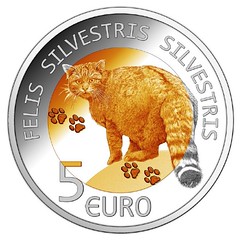

Lithuania- 2015 - 20 Euro Coin for Mikalojus Radvila

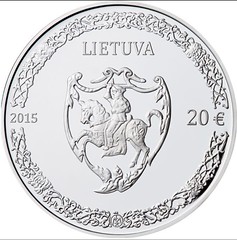
Poland Coin on Kazimierz Perzerwa-Tetmajer
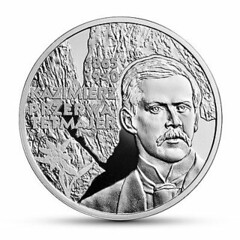
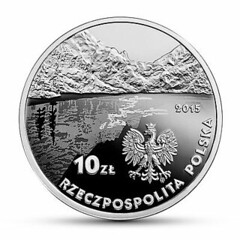
Czech Republic Coin on Thomas Bata
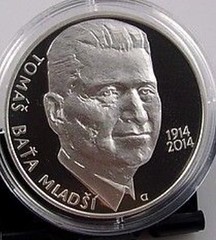
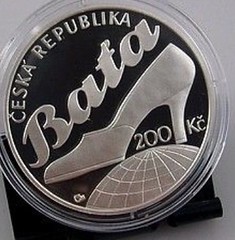
Finland Coin on Sisu
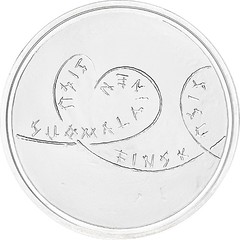
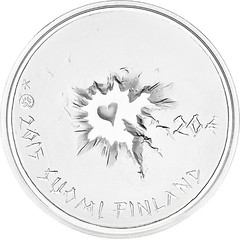
THE AGNUS DEI PENNY
Lee Toone writes:
One of the coins of the Lenborough hoard you illustrated last week is an extremely rare and important 'Agnus Dei' (lamb of God) penny struck by Aethelred the Unrede. In this case the coin is a mule as the reverse does not show the Holy Dove as is usual. Further information is given on the Fitzwilliam Museum website. This coin and part of the hoard are currently on display at the British Museum.
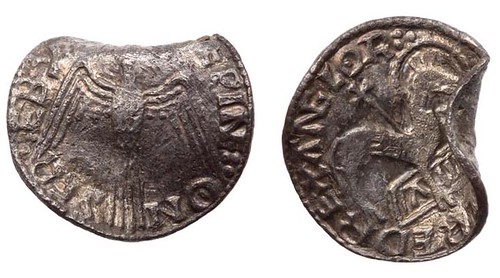
In the 970s and after England developed a remarkable monetary system characterised by standardised coin-types naming king, mint-place and individual maker (‘moneyer’) which were issued at up to seventy places across the kingdom, from York to Exeter and Dover. Every few years these coins would be brought in and replaced with a new type. Thanks to payments of tribute to the Vikings who menaced England during the reign of Æthelred, tens of thousands of silver pennies of most of these types have survived in hoards from modern Scandinavia.
Yet one particularly striking and historically important type remains poorly represented among them: the famous Agnus Dei (Latin for Lamb of God) type. Only 21 specimens have been discovered, all but four of them in Scandinavia or the Baltic. One of the latest to come to light was found near Epping, Essex, in 2008. It was subsequently bought for the Fitzwilliam Museum (accession number CM.1-2009).
Uniquely for the succession of types running from Edgar to Harold II in 1066, the Agnus Dei coinage dispenses with a representation of the king on the obverse and with the usual cross on the reverse. In their place, one finds a representation of the Lamb of God and of the Holy Dove. These images find extensive parallels among manuscript illuminations, sculpture and metalwork of the period, and demonstrate that the designers of coins were very much in touch with the artistic mainstream, and therefore presumably with the deep resonances which attached to these images. Both emphasise the peace-bringing power of Christ and the Holy Spirit
To read the complete article, see:
Agnus Dei penny of Æthelred II
(www.fitzmuseum.cam.ac.uk/dept/coins/exhibitions/CoinOfTheMoment/AgnusDei/)
To read the earlier E-Sylum article, see:
LARGE HOARD OF ANGLO SAXON COINS DISCOVERED
(www.coinbooks.org/esylum_v18n07a22.html)
COINS OF THE ANGLO-SAXONS
 The earliest Anglo-Saxon coins were imitations, or close copies, of gold tremisses that circulated
across the English Channel in France. Since the 17th century, numismatists have called these rare coins “thrymsas” but they were probably known as
“shillings” (or scillingas) and represented the price of a cow or sheep.
The earliest Anglo-Saxon coins were imitations, or close copies, of gold tremisses that circulated
across the English Channel in France. Since the 17th century, numismatists have called these rare coins “thrymsas” but they were probably known as
“shillings” (or scillingas) and represented the price of a cow or sheep.
A handful of larger coins, copied from late Roman solidi, were probably struck as royal gifts for special occasions. A hoard buried before 650 and discovered in 1828 at Crondall in Hampshire contained 73 diverse thrymsas, now in the Ashmolean Museum of Oxford University. Many have a crude bust on the obverse and a cross, surrounded by the name of a moneyer (such as WITMEN) on the reverse. “Moneyers” were private contractors, possibly goldsmiths, who produced coins on order for a king or bishop. Some thrymsas were struck at Canterbury, others at London. A few are known from York.
Thrymsas became more and more debased over time, until they were just silver coins with a trace of gold. About the year 680 gold disappears from the coinage. The silver coins that continued to be struck were probably called “penningas”, but thanks to one of those historical misunderstandings so common in numismatics, they are known today by a different Anglo-Saxon word: sceat, or sceatta, which means “wealth” or “treasure.”
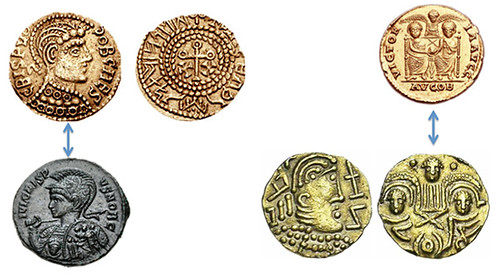
The so-called “primary sceattas” were struck for a period of about 25 years (c. 675-700). Thick coins, 12 – 13 mm in diameter, they weigh from 1.0 to 1.3 grams and are nearly pure silver (90-95%). Twenty grains of barley from the middle of the ear weigh almost exactly 1.3 grams, and this may have been the theoretical standard. The obverse design is typically a crude bust, with a few letters or runes of a fragmentary or garbled pseudo-inscription. A common reverse is derived from a “vexillum” – a Roman military standard or flag commonly depicted on fourth century coins. Another reverse type shows a bird atop a cross.
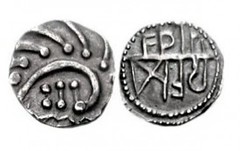 One of the most
common types is the “porcupine” – a whimsical description of the simple abstract obverse design, which may have started out as a bust (with the
“quills” representing hair brushed back) or as a depiction of a wolf (with the “quills” representing the bristling hair on the beast’s arched
back.)
One of the most
common types is the “porcupine” – a whimsical description of the simple abstract obverse design, which may have started out as a bust (with the
“quills” representing hair brushed back) or as a depiction of a wolf (with the “quills” representing the bristling hair on the beast’s arched
back.)
To read the complete article, see:
Coins of The Anglo-Saxons (www.coinweek.com/education/anglo-saxon-coins/)
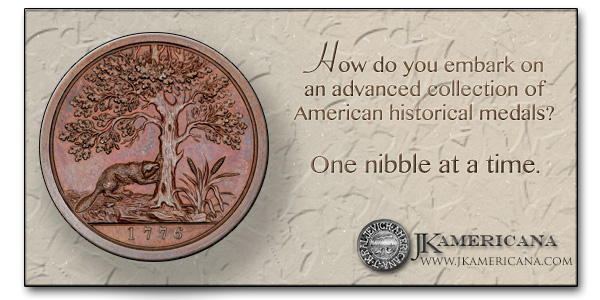
ISRAEL STRUGGLES TO STOP ARCHAEOLOGICAL SITE RAIDS
Tom Caldwell writes:
No splitting of the proceeds, finders fee or anything for the hoard found off the coast of Israel? Outrageous! For some the unintended consequence will to break the law and not report such finds.
Via Flickr, Stuart writes:
The Israeli authorities confiscated the entire lot and the finders received nothing in reward of their efforts and expense in recovering the hoard. This is an ill-wind for numismatics because that part of the world is extremely rich in antiquities and numismatic heritage, and finders will be more encouraged to syphon off finds and hoards into the black market and so the potential knowledge from such finds will be lost. Even worse, melted down!
It is amazing that this hoard, one of the most significant ever found, has remained intact and available for numismatic study. It will be interesting to read the report on this hoard when it is published but God knows when!
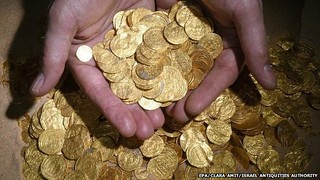 The staff of the Israel Antiquities Authority (IAA) gets very nervous whenever news breaks that a large archaeological treasure has been found. That
is what happened Feb. 17, when amateur divers discovered a treasure trove of rare, ancient coins near the ancient port town of Caesarea. “We know
that the discovery of a treasure of this size, and the publicity that such a find receives in the media causes people to think that they can find
treasures just about anywhere,” Eitan Klein, deputy director of the Unit to Prevent Antiquities Theft at the IAA, told Al-Monitor.
The staff of the Israel Antiquities Authority (IAA) gets very nervous whenever news breaks that a large archaeological treasure has been found. That
is what happened Feb. 17, when amateur divers discovered a treasure trove of rare, ancient coins near the ancient port town of Caesarea. “We know
that the discovery of a treasure of this size, and the publicity that such a find receives in the media causes people to think that they can find
treasures just about anywhere,” Eitan Klein, deputy director of the Unit to Prevent Antiquities Theft at the IAA, told Al-Monitor.
Klein said, “People take the law into their own hands and set out to find antiquities themselves, even though this means breaking the law and causing destruction to important archaeological sites. For the most part, they don’t even find anything. What was discovered last week is the kind of thing that happens just once every 50 years.”
Israel has been considered a major crossroads of international commerce throughout almost all of human history. As such, it is full of archaeological sites. The IAA estimates that there are about 30,000 such sites in the country, most of them not even fenced off. Anyone who wants to can start digging. And as it turns out, a lot of people do.
The IAA believes that the discovery of some 2,000 gold coins dating to the year 1000 at the bottom of the sea, in the submerged ancient port of Caesarea, will send the imagination of the country’s antiquities robbers into overdrive.
Just last December, a gang of six Palestinians was caught stealing antiquities in the Cave of Skulls in the Judean Desert. They were hoping to find ancient scrolls from the Second Temple period, and were carrying numerous artifacts including a lice comb from the Roman era. In another case, a gang of gold robbers was uncovered in the Hefer Valley, in the coastal central region of the country, while excavating a cave from the Roman-Byzantine period, 1,800 years ago, as well as Ottoman artifacts from 500 years ago, hoping to find gold there. On Feb. 1, robbers were caught breaking into ancient tombs in the Tel Ashkelon area. In their defense, they claimed that they were “just looking for worms to use as fishing bait.”
To read the complete article, see:
Israel struggles to stop
archaeological site raids (www.al-monitor.com/pulse/originals/2015/02/israel-palestinians-antiques-raiders-gold-coin-trove-theft.html#)
To read the earlier E-Sylum article, see:
ISRAELI SCUBA DIVERS FIND GOLD COIN CACHE (www.coinbooks.org/esylum_v18n08a27.html)
TREASURE HUNTERS SEEK CONFEDERATE GOLD IN LAKE MICHIGAN
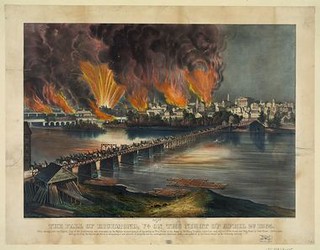 Sometime in the mid-1890s, a boxcar laden with gold bullion stolen from the
Confederacy at the end of the Civil War was allegedly pushed off a ferry into the roiling waters of Lake Michigan during a storm.
Sometime in the mid-1890s, a boxcar laden with gold bullion stolen from the
Confederacy at the end of the Civil War was allegedly pushed off a ferry into the roiling waters of Lake Michigan during a storm.
Today, it awaits discovery on the lake bottom.
As far as treasure stories go, it's a doozy. But is it believable?
Unfortunately, there's only one way to know for sure whether the story advanced by Muskegon area shipwreck divers Frederick J. Monroe and Kevin Dykstra is anything more than a new entry in the encyclopedia of theories about what became of the fabled Confederate treasury after the war.
Based largely on a deathbed confession relayed to Monroe in 1973, Monroe and Dykstra have spent several years searching the waters off Northern Michigan's Benzie County for the treasure, which they fully expect will be found this summer.
On board with the tale is Frankfort Superintendent Joshua Mills, who is excited by the economic prospects of treasure seekers descending on his coastal town en masse with a modern day version of gold fever.
Less convinced are Civil War historians, who consider the story preposterous.
"It's all a bunch of hogwash," said Rand Bitter, author of a biography about the Union Army officer at the center of Dykstra and Monroe's treasure theory.
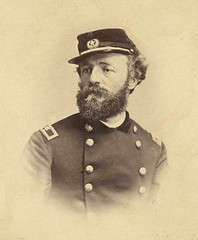 The
story bubbled into the public eye last fall, when Monroe and Dykstra announced the discovery of an unidentified Lake Michigan shipwreck bearing
resemblance to Le Griffon, the yet-undiscovered "holy grail" of Great Lakes wrecks.
The
story bubbled into the public eye last fall, when Monroe and Dykstra announced the discovery of an unidentified Lake Michigan shipwreck bearing
resemblance to Le Griffon, the yet-undiscovered "holy grail" of Great Lakes wrecks.
After the war, Minty's first wife, Grace Ann Abbott, was apparently seen in Traverse City with a necklace made from a Confederate gold coin sovereign -- a detail Dykstra and Monroe feel supports their theory.
To read the complete article, see:
Confederate treasure in Lake Michigan? Despite
skeptics, divers pursue fantastic story (www.mlive.com/news/grand-rapids/index.ssf/2015/02/confederate_gold_lake_michigan.html)

EXHIBIT HIGHLIGHTS COUNTERFEIT CHINESE NOTES MADE BY JAPAN
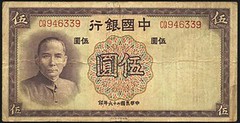 A recent discovery reveals that the Japanese army produced fake Chinese
banknotes in the billions of yuan during the Second Sino-Japanese War in an attempt to undermine the Chinese economy, reports China's Global
Times citing Japan's Asahi Shimbun.
A recent discovery reveals that the Japanese army produced fake Chinese
banknotes in the billions of yuan during the Second Sino-Japanese War in an attempt to undermine the Chinese economy, reports China's Global
Times citing Japan's Asahi Shimbun.
Japan's Noborito Institute Peace Education Resource Center at Meiji University is now exhibiting the counterfeit notes, which were left at the Tomoegawa paper mill in Shizuoka.
Researchers with the university have concluded after studying 279 sheets of 30 cm square papers that they were part of the Japanese army's operation to counterfeit bills used in the Republic of China (ROC) during the war.
The sheets of material, which also contain silk fibers, are printed with watermarks of the profile of ROC founding father Sun Yat-sen in a way that matches the 5-yuan bill that was widely circulated in China at that time.
Other sheets of material found had watermarks of the Temple of Heaven, a historic site that was printed on another kind of 5-yuan bill. The Japanese produced fake banknotes worth a total of 4 billion yuan from when the operation started in 1939, according to a former Imperial Japanese Army officer.
The Japanese army embarked on the project to encourage Chinese acceptance of the Japanese yen. Based on a book written by a former employee at the institute, the operation was part of Japan's economic strategy towards the ROC.
Akira Yamada, a professor of modern Japanese history at the university, said that although the Japanese government was involved in the project, the executing unit was the highly confidential Imperial Japanese Army's Noborito Laboratory, also known as the Ninth Army Engineering Laboratory where the university's Ikuta campus now stands.
"Having a company in the private sector involved in the project made it possible to make a vast volume of banknotes," said Yamada, who is also head of the Noborito institute.
The counterfeit money was produced in Hong Kong with Western technology. According to former army institute employees, the Japanese army confiscated the machines and plates and took them to the institute.
The exhibition at Meiji University will run until March 21, 2015.
To read the complete article, see:
Japan's forgeries of ROC banknotes go on display
(www.wantchinatimes.com/news-subclass-cnt.aspx?id=20150301000002&cid=1101)
COUNTERFEITING $100 BILLS WITH NAPKINS

Cass Alder, of Prince Edward Island, Canada, is a very ambitious 22-year-old.
Besides defrauding H&R Block of $5,267 CAD (or $4,216.64 in USD) using a fraudulent tax form, Alder has also been sentenced with counterfeiting charges in his hometown of Lennox Island. But it's really Alder's methodology that's deserving of some attention.
Alder purchased a package of napkins emblazoned with the image of a $100 Canadian dollar bill, cut out the images and pasted them to pieces of paper using a glue stick. He then baked the forgeries for a short time to ensure a solid hold.
Alder's plan crumpled like so many napkins when he attempted to spend the bills at a convenience store, only to have a clerk refuse to accept it. He then fled the store.
To read the complete article, see:
Enterprising 22-Year-Old Attempts to Counterfeit $100 Bills with
Napkins (www.people.com/article/cass-alder-counterfeits-bills-napkins)
COUNTERFEITING - IN REVERSE
Denver Police are investigating a bizarre case involving a man who conned a store clerk out of $20 while pretending to be a police officer.
“It’s kind of convoluted,” said police department spokesman Sonny Jackson. “Through a dialog with the clerk, the guy ends up discussing that this bill may be counterfeit and he says, ‘Give me the bill. I’m looking for counterfeit bills.’”
Jackson said the man then told the clerk he was an undercover Aurora cop, presented a card and even took his shirt off to show he was wearing a bullet proof vest.
Jackson said once they catch the impersonator, it will be up to the District Attorney to decide whether to file a theft charge in addition to one related to the impersonation.
To read the complete article, see:
Man impersonating police officer told
store clerk $20 bill looked counterfeit (www.thedenverchannel.com/news/local-news/man-impersonating-police-officer-sought-in-denver)
FEATURED WEB SITE: THE SHORT SNORTER PROJECT
This week's Featured Web Site is the Short Snorter Project.A short snorter is a banknote which was signed by various persons traveling together or meeting up at different events and records who was met. The tradition was started by bush pilots in Alaska in the 1920's and subsequently spread through the growth of military and commercial aviation. If you signed a short snorter and that person could not produce it upon request, they owed you a dollar or a drink (a “short snort”, aviation and alcohol do not mix!).
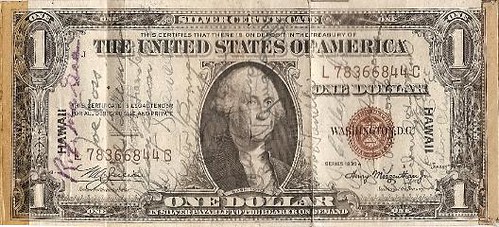
www.shortsnorter.org
